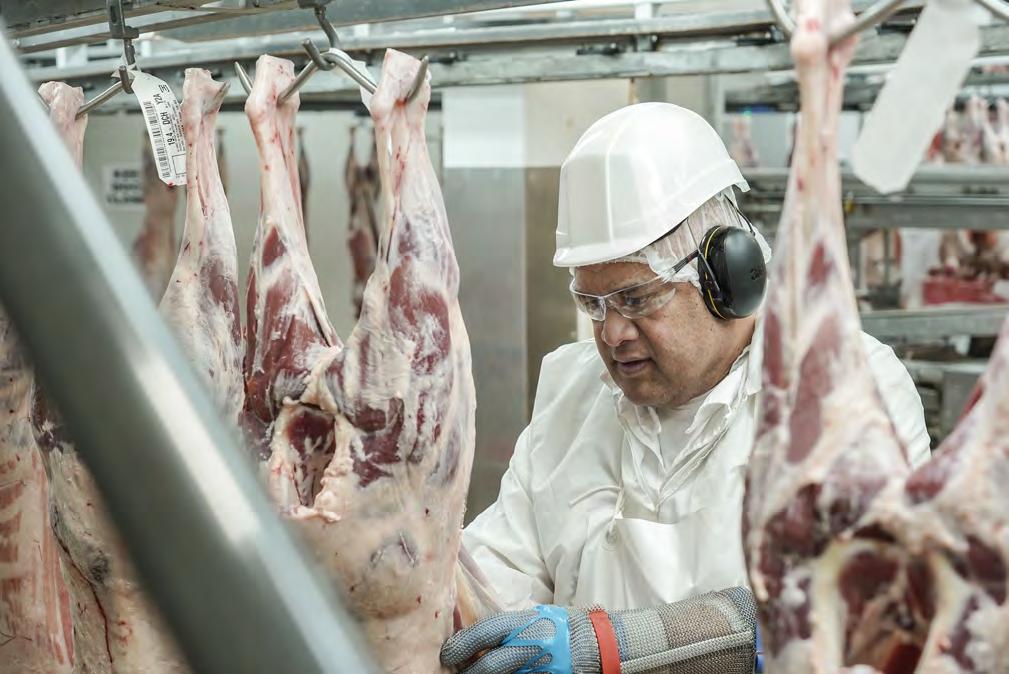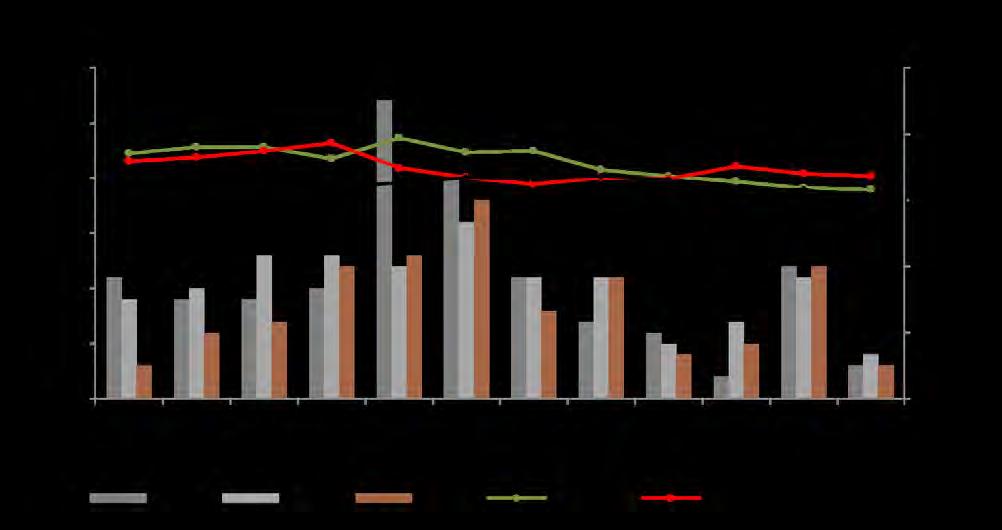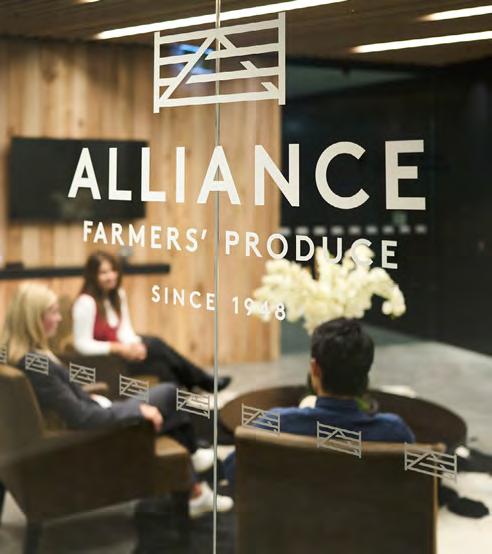

ANNUAL SNAPSHOT 01

Farmer-shareholders approve strategic investment partnership with Dawn Meats Group
Significant increase in profitability following disciplined, back-to-basics approach
Rebound in global pricing and demand in global markets
Continuing cost reduction
Capacity optimisation to match livestock flows
Record market share in beef
Business reset and strategy refresh deliver tangible results
Continuing improvements across Health & Safety to ensure our people return home safe and well each day

CHAIRMAN & CHIEF EXECUTIVE REVIEW
CHAIRMAN & CHIEF EXECUTIVE REVIEW
Alliance Group has had plenty of highs and lows in its 77-year history, but this past year has been one of the most significant.
In October, our farmer-shareholders made the decision to back a $276 million strategic partnership with Dawn Meats Group, one of Europe’s leading red meat processors.
This investment restores balance sheet strength, secures thousands of jobs across regional communities and will ensure Alliance has the scale and reach to compete and thrive in global markets.
While the decision was driven by financial necessity, it has also positioned Alliance for long-term success.
After two challenging seasons, it became clear that while farmers wanted a stronger balance sheet, many were unwilling to contribute further capital. The Board explored every credible option and concluded that Dawn Meats was the right long-term partner.
The partnership has brought together two complementary businesses -- Alliance’s leadership in lamb and strong presence in Asia, China, and North America with Dawn’s strength in beef and its extensive European market access.
It provides the financial stability, capability and reach required to continue building value while ensuring the interests of our farmers are safeguarded.
BACK TO BASICS
Following a full reset of the business, the company’s disciplined, back-to-basics approach -- focused on creating more market value, returning more value to farmers, and driving greater enterprise efficiency -- has guided every decision and delivered tangible results.
Over the past 12 months, we have strengthened the business by cutting unnecessary costs, optimising processing capacity, enhancing farmer offerings and investing in smarter technology.
We have lifted efficiency across the value chain, reduced inventory levels by around half compared with the same time last year, improved sales velocity, and, for the first time in three years, funded capital expenditure directly from free cash flow.
Operational improvements also lifted lamb and beef yields, reflecting improvements in plant performance and processing reliability. These gains are already making a meaningful difference to returns for farmers.

GLOBAL MARKETS
Across our key markets, pricing and demand remained positive, providing a welcome boost after two challenging years when many farmers’ businesses faced losses on the back of a sharp correction in ovine pricing in China.
While trading conditions in China remained difficult, our diversified approach helped balance overall performance. Strong demand in North America, Europe, and the United Kingdom contributed to the positive result.
Beef demand was particularly strong in the United States, where herd numbers are at their lowest for 75 years and domestic consumption remains high. That strength flowed through to farm-gate returns.
Our long-standing customer relationships again proved their value, helping maintain pricing stability and reliability for our farmers.
TECHNOLOGY
Technology has played a central role in Alliance’s turnaround. The new Enterprise Resource Planning (ERP) system improved transparency, strengthened financial control, and enhanced decision-making across the business.
Combined with disciplined cost management, sharper execution and processing improvements, these changes created a leaner, more agile company able to respond quickly to changing market conditions.

LOOKING AHEAD
The past year has been about getting back to basics: running the business efficiently, making better use of every dollar and rebuilding trust and confidence with farmers.
There’s still a lot of work to do, but the foundations are now in place.
We want to thank our farmers for their ongoing support. Their loyalty and commitment have been critical as we reshaped the business.
With the reset complete and our back-tobasics approach embedded across the business, Alliance is well placed to achieve our ambition of creating a high-performing company to benefit our people, our farmers, and our customers.
We would like to thank Team Alliance and the Board of Directors for their dedication and commitment in what was a very challenging year for the business.
A special note of thanks to the Directors who are retiring -- Sarah Brown, Chris Day, Don Morrison, Gray Baldwin and Richard Greer -their contributions have all played an integral role in the success of the business.
We look forward to an exciting future alongside our new partner Dawn, with the capability to thrive and deliver sustainable returns -- helping ensure livestock farming remains a competitive and valued land use well into the future.


Mark Wynne Chairman Willie Wiese Chief Executive Niall Browne, Chief Executive of Dawn Meats

MORE MARKET VALUE CREATION 04
MORE MARKET VALUE CREATION
MORE MARKET VALUE
Creating more market value remains at the core of Alliance Group’s strategy.
Over the past 12 months, we have been relentless in our focus on capturing the best possible returns for every animal processed and ensuring that value flows directly back to our farmershareholders.
The turnaround in company performance reflects disciplined market execution, stronger customer partnerships and a sharper focus on aligning sales with carcass optimisation.
For our farmers, this means more value returned to farm and a stronger, more resilient business.
CHINA
The past year highlighted the strength of diversification in our global markets. China, while remaining our largest single market by volume, proved to be the most challenging.


Consumer confidence was subdued, inventories were high, and pricing pressure was intense. Our approach was measured: rather than chasing volume, we prioritised stability and value, carefully managing exposure and protecting overall company returns.
NORTH AMERICA
By contrast, North America was a standout.
Record low herd numbers combined with record high protein consumption created exceptional trading conditions.
Alliance’s reputation for reliability, consistently delivering to specification and on time, enabled us to deepen trust with long-term customers.
This reliability, alongside the premiumisation of protein in the market, created strong opportunities for our Lumina and Handpicked programmes. Both flourished, adding significant value and helping drive greater carcass optimisation.

UNITED KINGDOM AND EUROPE
In the United Kingdom and Europe, protein shortages lifted demand and pricing.
Our Lumina and Handpicked Lamb brands maintained a premium despite rising commodity prices, with our UK Handpicked launch selling out immediately.
Continental Europe also rewarded provenance and quality, with chilled shipments commanding strong margins at a time when many competitors struggled with supply.
MIDDLE EAST
In the Middle East, Alliance refreshed our strategy, strengthening relationships with key customers in Jordan, Saudi Arabia and the Emirates.
This repositioning created fresh retail and food service opportunities and enhanced brand presence, with encouraging early signs including new listings and distributor feedback showing increased interest in Alliance branded products.
SHIFTING WITH DEMAND
Consumer behaviour also shifted over the year.
Globally, retail channels strengthened as households dined out less and traded down within categories. A flow-on effect of this change was that more people favoured home dining. Alliance adapted quickly, developing new retail-ready formats and pack sizes aligned with consumer preferences. This responsiveness helped secure new business, balance channel mix, and further improve value capture.
Our sales model has also been transformed, allowing us to respond more quickly to market changes and capture value closer to prevailing prices.
ERP DRIVEN EFFICIENCY
Supported by the new ERP system, which provides real-time visibility of inventory and sales data, Alliance's closing weighted average age of inventory went from 76 days to just 15. This dramatic improvement not only freed up working capital but also sharpened responsiveness, improved sales velocity and reduced exposure to volatility.
Through disciplined execution in global markets, targeted premiumisation and innovation, Alliance has delivered on its promise of maximising value for farmers while laying the foundations for long-term growth.

MORE ENTERPRISE EFFICIENCY 05
MORE ENTERPRISE EFFICIENCY
ENTERPRISE EFFICIENCY & OPERATIONAL GAINS
While stronger global markets have underpinned improved performance, equally important has been Alliance’s transformation in enterprise efficiency.
This has not been about headline-grabbing initiatives, but rather a disciplined, consistent commitment to doing the basics exceptionally well.
Gains in yield, waste reduction, labour stability, non-livestock procurement and sustainability have together delivered tens of millions of dollars in value, helping Alliance return to profitability.
PLANT NETWORK PERFORMANCE
Across the plant network, performance has improved significantly.
Mataura achieved a record season with major yield gains and strong uptime. Lorneville processed 203,000 more ovine, benefiting from both scale and efficiency improvements, while Levin also delivered material performance gains.
Beef and offal yields were a particular highlight, with tighter coordination between sales and processing ensuring cuts matched customer specifications. This alignment between market demand and plant execution is now embedded across the business and is lifting returns.
SUSTAINABILITY & WASTE REDUCTION
Waste reduction initiatives also contributed materially to both cost savings and sustainability. Skins once sent to landfill are now fully rendered, delivering $4.5 million in annual savings and reducing emissions.
Rendering plants were upgraded to increase meal production, ensuring more value is captured from each animal while meeting higher environmental standards.
At Mataura, the commissioning of an advanced wastewater UV treatment system set a new benchmark for industry performance and reinforced Alliance’s commitment to responsible operations.
On decarbonisation, heat pumps are now operating at all South Island plants, reducing reliance on coal and diesel. At the same time, targeted efficiency projects, such as reducing hot water use, ensure new systems can be right-sized, lowering both long-term costs and emissions.



WORKFORCE & SAFETY
Workforce stability has improved markedly with reliance on labour hire reduced to negligible levels.
Our Manufacturing Excellence programme has embedded a culture of continuous improvement across processing sites.
This has equipped teams to deliver consistently higher standards and positioned Alliance to perform strongly in peak seasons.
Safety has also remained a clear priority, with internal audits identifying and closing critical gaps. The strengthening of emergency response teams at Lorneville, Pukeuri and Mataura has lifted preparedness and compliance across the company.
PROCUREMENT & VALUE
Procurement discipline and overhead reductions further strengthened performance.
By consolidating non-livestock procurement, Alliance improved its bargaining power and offset inflationary pressures on energy and inputs.
Corporate overheads were reduced, and capital investment was prioritised to essential safety and compliance projects, asset replacement, and fast pay-back projects, ensuring resources were directed to where they added the most value.
These improvements across yield, waste, labour, procurement and sustainability are not isolated gains.
They are part of a wider cultural shift that embeds discipline and continuous improvement at every level of the business.
Together, they are building a leaner, stronger and more resilient Alliance — one that can consistently deliver sustainable returns to farmer-shareholders in the years ahead.

06
MORE VALUE FOR
FARMER SHAREHOLDERS
MORE VALUE FOR FARMER SHAREHOLDERS
The 2024-25 season has been one of the most challenging and dynamic in recent years, shaped by extreme weather events, shifting livestock flows, and a highly competitive procurement environment.
Yet despite these pressures, Alliance Group and its farmers have demonstrated real resilience and adaptability.
SEASON OVERVIEW
The season began with severe storms across Southland, Otago, and Canterbury in September/ October, resulting in the loss of close to one million lambs.
The cold, wet spring that followed slowed livestock growth and recovery, delaying livestock readiness for processing through the early summer months.
At the same time, the longer-term effects of land-use change — particularly conversions to forestry/carbon farming, became more apparent, with national sheep and cattle numbers falling further than expected.
By mid-summer, conditions had reversed. Warmer, dry weather through January to March created strong pasture growth in many regions, prompting farmers to hold stock longer to maximise weights and take advantage of improving prices.
This tightened livestock availability and created intense procurement competition across the industry, particularly from February onwards.
For the third consecutive year, there was no significant peak in livestock flows or processing backlogs, other than a brief two-week period in May when dairy cows came on. This allowed the company to maintain steady processing throughout the season and continue to deliver efficiency benefits.
SUPPORTING OUR FARMERS
In a season of volatility, Alliance continued to work closely with farmers to help them navigate changing conditions.
To maintain plant efficiency, we sourced additional livestock beyond forecasts and traded a record 1.5 million store-lamb equivalents — our highest ever.
We also facilitated the transfer of significant livestock volumes across regions, including more than 650,000 lambs from Southland to Canterbury in late autumn, ensuring both breeders and finishers could meet their respective needs.
Through our store stock and advanced payment programmes, we provided valuable on-farm support, helping farmers manage cash flow and reinvest in their businesses.
The company’s store stock programme has continued to grow, delivering strong commercial returns to breeders with no commission charge, while our advance payment programme remains an important tool for farmers needing working capital during tighter months.

FARMGATE RETURNS
After two difficult years, the sharp recovery in farmgate prices was welcome and timely. Lamb schedules lifted by more than $2 a kilogram over the season, while beef returns improved by around $3 a kilogram.
These gains reflected a combination of strengthening global market prices and intense procurement competition in the latter part of the season.
Importantly, the total payments made to farmers were significantly higher than in prior years, with a greater share of value flowing back to the farm gate.
This improvement has enabled many farmers to restore cash flow, reinvest in fertiliser and maintenance and strengthen their financial position after an extended period of pressure.
REWARDING QUALITY
Our commitment to rewarding farmers for producing quality livestock remains at the heart of the company’s strategy.
The expansion of our premium programmes, including Pure South Handpicked Beef and Lamb, and the continued roll-out of MEQ technology, have created new opportunities for farmers to benefit from objective measurement and market premiums.
Alliance is among the few companies globally able to reward farmers for both eating quality and yield using independent, objective data.
Returns from marbling in lamb, for example, are now approaching those achieved through our Lumina Lamb programme.
In beef, farmers using MEQ feedback are making more informed breeding and finishing decisions, achieving premiums of up to 60 cents per kilogram.
Participation in these premium programmes continues to rise strongly, with close to 800,000 lambs expected to be processed through the Handpicked programme in the coming season.
MEQ probe showing the scan score for a carcase on the chain.
MARKET SHARE AND SPECIES PERFORMANCE
Lamb market share was initially lower in October and November as a result of the capital raise livestock deductions but strengthened steadily from January onwards as committed supply increased.
Mutton volumes were consistent with prior years, while beef throughput grew significantly as we continued to execute our strategy of increasing beef processing.
Our venison market share eased following the closure of the Smithfield plant, although new partnerships such as the Elk Collective are beginning to rebuild momentum.
DELIVERING VALUE
Alliance remains focused on delivering value to our farmer-shareholders through stable processing, fair pricing, and quality-based rewards.
Our investment in technology, digital tools and livestock representative capability has improved communication and data flow, strengthening on-farm relationships and service delivery.
Together with our farmers, we have weathered climate challenges, sustained performance, and created a stronger foundation for the year ahead.




LAMB SWEET SPOT
BEEF IMF

SUPPORTING OUR PEOPLE AND COMMUNITIES
SUPPORTING OUR PEOPLE AND COMMUNITIES
TEAM ALLIANCE
At Alliance, our people are at the heart of everything we do. Their commitment and care underpin our success and define what it means to be part of Team Alliance.
In 2025, we continued to build a workplace where our people can thrive, one that attracts, develops and retains talented individuals who share our values and take pride in producing world-class New Zealand red meat.
Over the past year, we embedded “The Way We Work” across all sites, and invested in training and wellbeing initiatives that support our people to grow and succeed.
Despite ongoing industry challenges, engagement and retention remain strong, a testament to the resilience and commitment of our people.
During the year, we:
+ Expanded leadership and development programmes to all sites
+ Continued embedding our values and “The Way We Work” into recruitment, performance, and recognition systems
+ Improved recruitment and on-boarding processes to ensure we have the right people, in the right roles, at the right time

HEALTH, SAFETY AND WELLBEING
Nothing matters more than ensuring our people return home safe and well every day.
Over the past year, we continued to strengthen our safety systems, leadership accountability, and culture of care across all our sites.
We completed the third year of our internal health and safety programme, with an overall compliance rate of 76 per cent, and continued our focus on fatality risk management and prevention.
Key highlights include:
+ Fatality risk management remains an important focus for Alliance. The company has progressed to the next phase of our plan to develop Bow Tie Risk Models on potentially fatal events, which highlight the critical controls required to prevent a serious incident. These in turn have led to “in field” critical control verification checks, which provide us the reality check that high hazard work activity is performed safely.
+ All our plants received compliance assessment visits from WorkSafe New Zealand during the year which included discussions with elected health and safety representatives.
+ New ACC annual audit standards took effect this year to enable Alliance to remain in the ACC Accredited Employer Programme. It was pleasing to achieve a full pass on the standards, which were a higher level than previously required.
While we continue to report Total Recordable Injury Frequency Rate (TRIFR), we are increasingly using lamb equivalents processed per recordable injury to measure progress relative to throughput. As a forward-looking indicator, we use audit outcomes against our Safety Management System (SMS).
Safety Performance
TRIFR: FY25 TRIFR: 15.1 versus FY24 TRFIR: 16.8, which represents a 10% improvement. Lamb equivalents per recordable injury: FY25: 77,179 versus FY24: 72,420, which represents a 7% improvement.

These results show continued progress toward our goal of eliminating harm and embedding a proactive, prevention-first culture across the company.
GROWING CAPABILITY
We continued to invest in the growth and development of our people through structured training, apprenticeships and leadership development programmes.
Our training pathways help employees gain both internal certifications and nationally recognised qualifications.
LEADERSHIP DEVELOPMENT
Our flagship leadership programme, The Way We Lead, continued to grow, with 37 leaders completing the programme during FY25.
Cohort 1, Aug 2024 – Jan 2025 | 19 leaders
Cohort 2, July – November 2025 | 18 leaders
Alongside initiatives such as People Foundations and 7 Habits of Highly Effective People, these programmes are equipping our leaders to create safe, engaged, high-performing teams.
SUPPORTING OUR COMMUNITIES
Alliance is deeply connected to the communities where we live and work. We take pride in supporting initiatives that make a real difference to the lives of our people and their families.
SUPPORTING FUTURE TALENT
Each year, Alliance supports the next generation through bursaries for the children of our employees and shareholders.
PARTNERSHIP WITH RONALD MCDONALD HOUSE SOUTH ISLAND
NZ Certificate in Meat Processing — Bronze Induction LCP (30841) 263
NZ Certificate in Meat Processing — Halal (LCP) 2
NZ Certificate in Meat Processing Meat Manufacturing (Silver) (35955) 27
NZ Certificate in Business — Team Leadership (Silver) 44
*Total number of people who achieved the certification
CELEBRATING OUR PEOPLE
In April, we held our first-ever Alliance values awards.
It was a special afternoon as Team Alliance came together for the virtual awards ceremony to celebrate our cumulative success, high performers and culture champions.
The awards presented a unique and special opportunity for us to pause, reflect and recognise the hard work and dedication of Team Alliance and showcase the outstanding individuals who demonstrate our Alliance values and Way We Work behaviours every day.

In 2025, we continued our support for Ronald McDonald House South Island, which provides accommodation and care for families with children receiving hospital treatment away from home.
Our partnership helps ensure families, like Jess' (pictured below), can stay together and feel supported during some of their most difficult times. This year, our people once again got behind the cause and volunteered while Alliance donated meat products for family dinners. Together, we’re helping make life a little easier for families facing big challenges — an expression of the care and community spirit that runs through Team Alliance.


Employee Family Member Bursary: Sarah Puller — Studying degree in Agricultural Science, majoring in Environmental Management at Lincoln University
Shareholder Undergraduate Bursary: Charlie Withers — Studying Bachelor of Commerce (Agriculture) at Lincoln University
These bursaries help young people connected to Alliance pursue studies that will strengthen New Zealand’s primary industries and rural communities.

Jess in 2023 with all her school achievements.

GOVERNANCE 08
BOARD OF DIRECTORS

Mark Wynne Chairman

Don Morrison Supplier Representative

Jared Collie Supplier Representative

Matt Iremonger Supplier Representative
Mark joined the Board in December 2021 and was elected Chair in April 2024. He is also Chair of Quayside Holdings, a large Tauranga-based endowment fund. He has extensive experience in senior executive roles, including CEO of Ballance Agri-Nutrients, Regional President (South Asia) for Kimberly-Clark, and senior roles across Asia, the Middle East and New Zealand for Fonterra Brands.

Richard Greer Supplier Representative
Richard was elected in 2023. With his wife Kylie, he runs Sunnyside Station in Western Southland, a 1600-hectare sheep, deer and beef farm. They are also involved in a tourism business, combining farming with diversification. Richard brings valuable insights into both traditional and emerging rural enterprises.

Chris Day Independent Director
Appointed to the Board in December 2024, Chris is an independent director with extensive corporate, leadership and governance experience. He is the Chief Financial Officer of Foodstuffs South Island Limited and is a director of Datacom Group Limited.
At Alliance, Chris is Chair of the Audit and Risk Committee.
Don was elected in 2013. He farms sheep and cattle on 465 hectares at Waikaka Valley, Southland, through DG & BC Morrison Limited. Don also serves as director of Pure Taste NZ Limited, Te Ao Kakano Limited, and Ahika Journeys Limited, and is Chairman of W9. He is also a member of the Alpha Sheep Genetics Group.
was
Along with his wife Prue and their three sons, he operates a 1325-hectare sheep, cattle and dairy farm in Central Southland.
Jared is also a director of Ballance Agri-Nutrients, Benmore Downs Limited, and Platinum Dairies Limited. He serves as Chair of the Jeff Farm Management Board and is facilitator for the Takitimu Discussion Group.

Ross Bowmar Supplier Representative
Ross was raised in Southland and now farms with his wife Jess and family at a high-country sheep and beef station in Canterbury’s Rakaia Gorge. He holds a Masters in Agricultural Economics from Michigan State University and spent a decade with Archer Daniels Midland in international agricultural processing. He also serves as a director on EA Networks.

Sarah Brown Independent Director
Sarah lives in Manawatu and owns a sheep and beef farm.
She has held senior marketing and consumer insight roles with Lion Nathan, Colmar Brunton, Australian Pork, Boehringer Ingelheim, Diageo and Goodman Fielder International. She sits on the board of Dairy Goat Co-op (Chair of People and Culture) and runs an international marketing consultancy, advising clients across Australia, Asia and New Zealand.
At Alliance, Sarah chairs the People Committee.

Gray Baldwin Supplier Representative
Gray Baldwin and his wife Marilyn winter milk 850 cows, on an all-autumn calving system, on their 707ha property near Lichfield in South Waikato. The property includes substantial areas of maize and forestry land.
Gray’s past co-op governance roles include nine years with Ballance and ten years with LIC. Gray is also a director of Bioeconomy Science Institute and Farmlands.
His qualifications are a Masters in Agricultural Science and a Diploma in Business Administration (Massey) and a Masters in Theology (Otago). In 2015 he attended the Summer Institute of Co-operative Leadership at the University of Missouri. Gray also completed the Fonterra Governance Programme in 2010.
Matt was elected to the board in 2024 as a supplier representative.
Farming 40,000 SU sheep and beef on Banks Peninsula and 2,300 dairy cows across 3 dairy units in Canterbury, Matt was a Nuffield Scholar in 2023 and a past winner of the Deloitte Fast 50 Agribusiness.
Matt is passionate about capturing market value efficiently, returning it to farmers, and strengthening the balance sheet.
Jared
elected in 2015.
EXECUTIVE LEADERSHIP TEAM

Executive

Dr Aneesha Varghese-Cowan Chief Financial Officer

Willie was appointed CEO in March 2023. Prior to this he was General Manager Manufacturing, a role he held since December 2017.
Having led significant Manufacturing and FMCG businesses in both Australia and South Africa as well as Private Equity, Willie is experienced in the implementation of strategies that deliver performance improvements in complex businesses.
Willie has Mast ers degrees in Electrical Engineering, Industrial Engineering and Business Administration; from the University of the Witwatersrand, Johannesburg.

Murray Behrent
General Manager Livestock and Shareholder Services
Aneesha was appointed as Chief Financial Officer in 2024 and brings more than 25 years of finance transformation and governance experience across agribusiness, manufacturing, pharmaceuticals and blockchain technology in New Zealand and internationally.
Aneesha is a Chartered Accountant, holds a Masters in Taxation Studies from the University of Auckland and a Doctorate in Business Administration (with excellence) focusing on the future of the NZ red meat industry from the University of Otago, and is a Fellow of CPA Australia.
Aneesha is committed to building financial resilience, strategic transparency, and long-term value for the company and its shareholders.

Kirstie Gardener General Manager People & Culture
Murray joined Alliance in 1990 and has worked in multiple livestock-related roles. Appointed GM in October 2023 after serving as interim from June 2023. Murray has led major projects including the Farm Assurance Programme, Livestock Transport Accreditation, Central Progeny Test, and Via Scan Yield Grading.

Nigel Jones
General Manager Supply Chain and Planning
Appointed GM in May 2023 after serving as GM Strategy since 2015. Nigel has also held senior supply chain and logistics roles at Fonterra. He holds degrees in Accountancy and Finance, an MSc in Supply Chain and Logistics from Cranfield University, and has completed executive training at Stanford University.
Kirstie joined Alliance in April 2025. She is a seasoned executive and brings a wealth of experience in human resources, having held senior roles across a range of sectors and organisations, including ANZCO, Lyttleton Port Company, Solid Energy, and Holcim.

Sheena Henderson Global Marketing Director
Sheena has over 30 years of experience in global food and agribusiness, including leadership roles at Fonterra. She has also been a professional director for more than 15 years, providing governance and advisory services. She holds BSc and BBS degrees from Massey University.
Wayne joined Alliance in December 2023 after 32 years in red meat processing, including 23 years at Silver Fern Farms where he was Operations Manager for Sheep and Venison. Most recently he was COO Processing and Special Projects at Harvest Road Group in Western Australia. Wayne holds a Bachelor of Technology (First Class Honours) and an MBA (Distinction) from Massey University.

Appointed in January 2024, James has built his career in the red meat industry, previously holding senior global sales roles at Ovation NZ, with 10 years working in the United Kingdom, Europe and North America.
Since joining Alliance in 2019, he has led planning, optimisation, and plant management.
He holds a Bachelor of Physical Education and a Bachelor of Commerce (Otago), with postgraduate study in Managerial Finance and Executive Leadership training at Stanford University.

and Company
Nicole joined Alliance in 2022 as part of the legal team and was promoted to General Counsel and Company Secretary in 2024.
Before joining Alliance, Nicole gained extensive experience as legal counsel at Philips International and Pharming N.V., both based in the Netherlands, and advised large corporate, iwi, and local government clients while in private practice in New Zealand.
In addition to her role at Alliance, Nicole served as an Associate Director of Central Plains Water Limited from 2023 to 2024. Nicole and her husband Rob own a small sheep and beef farm in Darfield.

Bruce was appointed Chief Transformation Officer in July 2025.
He has been with Alliance Group since 1994, most recently serving as Group Contribution Optimisation Manager. Over his long career with the company, Bruce has held a range of senior roles, including 17 years as Plant Accountant at the Pukeuri processing plant and six years as Commercial Manager for Manufacturing.
Bruce is a director of Silere Alpine Origin Merino and serves as the alternate for CEO Willie Wiese on both the High Health Alliance (HHA) Board and the Meateor Board.
He holds a Bachelor of Commerce, majoring in Information Science, and a Graduate Diploma in Accounting from the University of Otago.
Willie Wiese Chief
Wayne Shaw General Manager Safety and Processing
James McWilliam Global Sales Director
Nicole Godber General Counsel
Secretary
Bruce McCrone Chief Transformation Officer
CORPORATE GOVERNANCE
Alliance Group is a co-operative company owned by more than 4,100 farmers who supply livestock to the company for processing and then selling the resulting meat and co-products to international markets.
BOARD OF DIRECTORS
The Company’s constitution states that there should be no more than ten directors at any time, with at least six and no more than eight being elected by shareholders. One-third of the elected directors must retire by rotation each year and may stand for re-election.
Due to the Dawn Meats transaction, a new governance structure will be implemented for the coming year which was set out in the Scheme Booklet.
BOARD RESPONSIBILITIES
The board holds statutory responsibility for the company’s affairs and activities. Dayto-day operations are managed by the chief executive, under the board’s delegation. The Board approves the company’s long term strategic direction, the annual business plan, and the capital expenditure budget. It also oversees specific project expenditures outside of normal authority and reviews the company’s performance against business plan objectives. Additionally, the board ensures regulatory compliance, upholds high ethical standards, and promotes the company’s role as a responsible corporate citizen, particularly focusing on employee health and safety and environmental sustainability. Conflicts of interest are registered and recorded by all directors, and succession planning is undertaken to ensure the necessary skill set remains available.
BOARD MEETINGS
Twelve Board meetings are scheduled annually, with additional meetings held as needed. Directors receive comprehensive management reports before these meetings. The board encourages the chief executive to involve employees who can offer valuable insights.
BOARD COMMITTEES
The board has established three committees to support governance and decision-making. Each operates under its own terms of reference and reports back to the board.
AUDIT AND RISK COMMITTEE
The Audit and Risk Committee consists of five directors and is chaired by Chris Day. It is responsible for overseeing, reviewing, and advising the board on risk management, financial reporting, internal and external audit activities, treasury matters and internal control frameworks.
PEOPLE COMMITTEE
The People Committee also has four directors and is chaired by Sarah Brown. This committee oversees the company’s people strategy and assists the board on policies and procedures related to remuneration and performance management. It plays a key role in the appointments, remuneration, and reviews of directors, the chief executive and senior management.
CAPITAL STRUCTURE BOARD COMMITTEE
The Capital Structure Board Committee is comprised of five directors and is chaired by Mark Wynne. The Committee is responsible for overseeing the company’s capital raise, announced earlier this year, and proposals on overall capital structure. The Committee supports the board in its discussions on optimal capital structure to support the company’s strategic goals.
ASSOCIATE DIRECTOR APPOINTMENT
The Associate Director is appointed at the board’s discretion for a 12-month term. While they attend all board meetings, they do not have voting rights. The board elected to leave this position vacant for the 2024 – 2025 year.
COMMUNICATIONS WITH SHAREHOLDERS
Alliance strives to keep shareholders informed of significant developments affecting the company. Information is shared via the Alliance Group website, Annual Report and the fortnightly e-newsletter “Brief Bites”. This year the board called a Special General Meeting to consider the Dawn Meats Transaction. Additionally, this year the company undertook 24 roadshow meetings to discuss the Dawn Meats transaction.
DIRECTOR MEETING ATTENDANCE
The following shows the percentage attendance of directors (based on their tenure) at board and committee meetings for the year ended 30 September 2025.

OUR FINANCIAL STATEMENTS
OUR FINANCIAL STATEMENTS
CONSOLIDATED INCOME STATEMENT
CONSOLIDATED STATEMENT OF COMPREHENSIVE INCOME
For the year ended 30 September 2025
CONSOLIDATED STATEMENT OF FINANCIAL POSITION
As at 30 September 2025
CONSOLIDATED STATEMENT OF CHANGES IN EQUITY
For the year ended 30 September 2025 Components
CONSOLIDATED STATEMENT OF CASH FLOWS
For the year ended 30 September 2025
The notes to the Group financial statements form an integral part of these financial statements.
NOTES TO THE CONSOLIDATED FINANCIAL STATEMENT S
IN THIS SECTION
The notes to the financial statements within sections A to F include information that is considered relevant and material to assist the reader in understanding changes in the Group's financial position or performance. Information is considered material if:
- the amount is significant because of its size and nature;
-it is important for understanding the results of the Group;
-it helps explain changes in the Group’s business; or
-it relates to an aspect of the Group’s operations that is important to future performance.
ABOUT THIS REPORT
Reporting entity
Alliance Group Limited (the Company) is a for-profit entity domiciled in New Zealand and registered under the Companies Act 1993 and the Co-operative Companies Act 1996. The Company is an FMC Entity in terms of the Financial Markets Conduct Act 2013 and prepares its financial statements in accordance with this Act and the Financial Reporting Act 2013.
These consolidated financial statements are for the Company and its subsidiaries (together referred to as "Group") and the Company's interests in associates as at and for the year ended 30 September 2025.
The Group is primarily involved in meat processing and export sales.
Statement of compliance and basis of preparation
The financial statements have been prepared:
-in accordance with Generally Accepted Accounting Practice (GAAP) in New Zealand and comply with International Financial Reporting Standards (IFRS) and the New Zealand equivalents (NZ IFRS), as appropriate for a for-profit entity;
-on a going concern basis; and
-in New Zealand dollars, with all values rounded to the nearest thousand dollars unless otherwise stated.
In preparing the Group financial statements, all material intragroup transactions, balances, income and expenses have been eliminated. Subsidiaries are consolidated on the date on which control is obtained to the date on which control is lost.
The financial statements are prepared for the 52-week period ending 27 September 2025 (last year: 52-week period ending 28 September 2024) due to the 4-4-5 calendar used by the Group.
This method is used to ensure comparability given the weekly trading cycles of the Group. For simplicity, the financial statements and accompanying notes will be presented and referred to as at 30 September year end.
Going concern
The financial statements have been prepared on a going concern basis, which assumes that the Group will be able to continue in operation for the foreseeable future and meet its obligations as they fall due.
At balance date, the Group current liabilities exceeded current assets by $158.1m (last year: $178.2m). This is due to the short-term nature of the interest-bearing loans and borrowings of $209.7m (last year $220.8m). These debts are classified as current as the facility matures on 18 December 2025. The proceeds from the capital raise will be primarily used to repay the short-term debt returning the group to a positive working capital position.
At balance date, the Group was in the process of securing additional capital to fund its operations and meet its obligations as they fell due. Whilst an agreement with Dawn Meats had been signed prior to year end, several conditions were still required to be met at balance date including shareholder vote, OIO and High Court approval.
Going concern (Cont)
Dawn Meats Corporate Group (“Dawn Meats”) is headquartered in Ireland, and is investing in Alliance through its nominated investment vehicle Delmec Unlimited, a company incorporated in the Isle of Man.
On successful completion of the capital raise and repayment of significant debt including discharging Westpac New Zealand from the banking syndicate, a continuation of the facility until maturity date has been agreed as per the amended facilities agreement signed on 26 September 2025, refer to note C7.
Subsequent to balance date, all material conditions have been met securing sufficient funding to support its ongoing operations and meet its financial obligations for at least the next twelve months. The transaction is set to be completed in early December 2025 and the proceeds to be received in full at that time.
The Directors have incorporated the capital raise and new banking terms into the forecast for the next financial year.
As a result, the Directors have concluded that the going concern basis of preparation is appropriate, and no material uncertainty exists at the date of approving these financial statements. Refer to note F5 — Events after balance date for more information on the Capital Raise.
Foreign currency
Transactions denominated in a foreign currency are converted at the exchange rates at the dates of the transactions. Foreign currency assets and liabilities (such as receivables and payables) are translated at the rate prevailing at balance date.
The assets and liabilities of international subsidiaries are translated to New Zealand dollars at the closing rate at balance date. The revenue and expenses of these subsidiaries are translated at rates approximating the exchange rates at the dates of the transactions.
Exchange differences arising on the translation of subsidiary financial statements are recorded in the foreign currency translation reserve (equity). Cumulative translation differences are recognised in the income statement in the period in which any international subsidiary is disposed of.
The principal functional currency of international subsidiaries is the British Pound Sterling; the closing rate at balance date was 0.4307 (last year: 0.4741).
Other accounting policies
Other accounting policies that are relevant to an understanding of the financial statements are provided throughout the notes to the financial statements. The accounting policies have been consistently applied to the periods in these financial statements. Where applicable comparatives have been amended to align with current year’s expenses.
Critical judgements and estimates
The preparation of financial statements requires management to exercise its judgement in applying the Group's accounting policies. Estimates and judgements are reviewed by management on an on-going basis, with revisions recognised in the period in which the estimate is revised and in any future periods affected. Areas of estimate or judgement that have most significant impact on the amounts recognised in the financial statements are:
-Note B1 Impairment
-Note B2 Inventories
-Note B3 Intangible assets
-Note D2 Derivative financial instruments
-Basis of preparationGoing Concern
Comparatives
Some comparative balances have been reclassified and restated to conform with changes in presentation and classification adopted in the current period.
A. FINANCIAL PERFORMANCE
IN THIS SECTION
This section explains the financial performance of Alliance providing additional information about individual items in the income statement, including:
-accounting policies, judgements and estimates that are relevant for understanding items recognised in the income statement.
-analysis of Alliance's performance for the year by reference to key areas including: revenue, payments to our farmers, expenses and taxation.
A1 REVENUE
Other operating income materially consists of recovery of expenses and rental income (last year: recovery of expenses and rental income)
Segment Reporting
In the following table, revenue from the sale of goods is disaggregated by geographical market. 20252024 $000$000
1,036,829970,469
395,565370,992
2,057,8631,772,215
Revenue measurement and recognition
Revenue from the sale of goods is measured at an amount that reflects the consideration expected to be received in exchange for transferring those goods. The measurement is based on the transaction price, net of commissions, volume rebate, and excludes amounts incurred on behalf of the customer.
In respect of export sales, the largest category of sales, the Group has determined that there are two performance obligations. The Group is obligated under the contract to supply specified goods and arrange and pay for shipping and insurance on behalf of the customer. Control of goods passes, and the service of arranging shipping and insurance is complete, at the point when the goods have been loaded onto the first point of carriage, to be delivered to the customer’s chosen destination. Revenue is recognised at this point in time.
Measurement & recognition
Interest income or expense is recognised using the effective interest rate method.
Financial expenses comprise interest expense on borrowings including related fees and losses on interest rate hedging instruments and the interest component of lease payments.
A3 PERSONNEL EXPENSES
Included within cost of sales in the income statement are wages and salaries of $315.5m (last year: $336.3m). The remaining personnel expenses are included within administrative expenses, sales and marketing expenses. In addition to the capital raise costs disclosed in note C5, transaction costs of $995,120 have been incurred to 30 September 2025 and are included within personnel expenses under administrative expenses in the income statement.
Measurement & recognition
Provision is made for benefits owing to employees in respect of wages and salaries, annual leave, long service leave and short term and long term employee incentives for services rendered. Provisions are recognised when it is probable they will be settled and can be measured reliably. They are carried at the remuneration rate expected to apply at the time of settlement. Obligations for contributions to defined contribution pension plans are recognised as an expense in the income statement when they are due.
Liabilities recognised in respect of long service leave are measured at the present value of the estimated future cash outflows expected to be made by the Group in respect of services provided by employees up to the reporting date.
Measurement & recognition
and also excludes items that will never be
A4.2Deferred tax
Movement in temporary differences during the year
plant and equipment
Balance at 1 October 2023 (3,421)2344,5852,472 957 28,05432,881
Recognised in income (680)1,2095,192(252)(417)21,95927,011
Recognised in equity (1) - - -(1)
Reallocate prior year between current and deferred tax (403) -(807)(934) -1,878(266)
Balance at 30 September 2024 (4,505)1,4438,9701,28654051,891 59,625
Balance at 1 October 2024 (4,505)1,4438,9701,286 54051,89159,625
Recognised in income (7,042)(803)(4,253)(81)(1,689)10,745(3,123)
Recognised in equity 3 - - -3
Reallocate prior year between current and deferred tax (1,591)(162)(593) 76 -2,081(189)
Balance at 30 September 2025 (13,135) 478 4,1241,281(1,149)64,71756,316
Based on future cashflow forecasts in the Group's five-year integrated plan, the Group considers it probable that future taxable profits will be available against which the tax losses can be recovered, and therefore related deferred tax asset can be realised.
Measurement and recognition:
Deferred tax is income tax that is expected to be payable or recoverable in the future as a result of the unwinding of temporary differences. These arise from differences in the recognition of assets and liabilities for financial reporting and for the filing of income tax returns. Deferred tax is recognised on all temporary differences, other than those arising from goodwill and the initial recognition of assets and liabilities in a transaction (other than in a business combination) that affects neither the accounting nor taxable profit or loss.
Deferred tax is calculated at the tax rates that are expected to apply to the year when a liability is settled or an asset realised, based on tax rates and tax laws that have been enacted or substantively enacted at balance date.
B. OPERATING ASSETS
IN THIS SECTION
This section shows the assets the Group uses in the processing of red meat products supplied by our New Zealand farmers in order to generate operating revenues. Key revenue generating assets include:
-Property, plant and equipment
-Inventories
-Intangible assets
-Right-of-use assets
B1 PROPERTY, PLANT AND EQUIPMENT
B1 PROPERTY, PLANT AND EQUIPMENT (CONT)
Measurement & recognition
Owned assets
Items of property, plant and equipment are measured at cost less accumulated depreciation and impairment losses.
Cost includes expenditures that are directly attributable to the purchase of the asset. The cost of self-constructed assets includes the cost of materials and direct labour, any other costs directly attributable to bringing the asset to a working condition for its intended use and the costs of dismantling and removing the items and restoring the site on which they are located. Purchased software that is integral to the functionality of the related equipment is capitalised as part of that equipment.
Where parts of an item of property, plant and equipment have different useful lives, they are accounted for as separate items of property, plant and equipment.
Work in progress relates to expenditure on items of property, plant and equipment which are not yet available for use. When an asset is made available for use it is transferred from work in progress to the relevant asset category and depreciated across its useful life.
Impairment
The carrying value of property, plant and equipment are reviewed at each reporting date. If an indicator of impairment exists, then the recoverable amount is estimated. An impairment loss is recognised in the income statement if the carrying amount exceeds the recoverable amount.
Disposals
The gain or loss arising on the disposal or retirement of an item of property, plant and equipment is determined as the difference between the sale proceeds and the carrying amount of the asset and is recognised in the income statement.
Depreciation
Depreciation of property plant and equipment assets is calculated on a straight-line or diminishing value basis. This allocates the cost of an asset, less any residual values (estimated value at time of disposal) over the estimated remaining useful life of the asset. Leased assets are depreciated over the shorter of the lease term and their useful lives.
Key judgement
The Group makes estimates of the remaining useful lives of assets, which are as follows;
-Buildings 15 - 67 years
-Plant and equipment
2.5 - 25 years
The residual value and useful lives are reviewed and if appropriate adjusted, at each reporting date.
The Group makes estimates or exercises judgement in assessing indicators of impairment, forecast future cash flows, and determining other key assumptions used for assessing fair values (less cost of disposal) or value in use.
Impairment tests
While the group has seen improvements in the performance from prior year, posting a net profit before tax of $24.6m, it has continued to be impacted by tough trading conditions and the high cost of debt. This has led the Group to conclude that indicators of impairment, under the accounting standard, exist as at year end.
Where an indicator of impairment is identified, accounting standards require that an impairment test is performed for each cash-generating unit (“CGU”). To assess the recoverable amount of the net assets of the Group, management has considered several relevant valuation data points: the fair value of the Group with reference to the Dawn Meats capital raise (refer note F5), independent valuations prepared by Northington Partners and Deloitte and management developed discounted cash flow models using the value in use (“VIU”) method for the CGU. An impairment loss is recognised if the carrying amount of an CGU exceeds its recoverable amount.
The key assumptions used in the estimation of the recoverable amount are set out below. The values assigned to the key assumptions represent the Group’s assessment of future trends in the industry and have been based on data from both external and internal sources.
The VIU calculation used five-year future cash flows based on Board approved business plans and is discounted based on a weighted average cost of capital ("WACC") of 12.13% pre-tax (8.73% post tax). The cash flow forecast included specific estimates for five years and a terminal growth rate of 2.00% thereafter. Cash flows are based on historical margin levels of between 2.00% and 4.00%, stable livestock volumes, and management’s views on market trends, pricing and yields.
B1 PROPERTY, PLANT AND EQUIPMENT (CONT)
The Group is confident in the results of the planned initiatives, and the results of the VIU indicated significant headroom above the carrying amount of the assets.
The group has carried out sensitivity analysis and determined the following reasonably possible changes in key assumptions, across the forecast period, and their impact on headroom:
Changes in key assumption Decrease in headroom
5% reduction in contribution margin* ($) (91,399)
0.5% increase in discount rate (50,801)
5% reduction in livestock volumes (186,667)
increase in capital expenditure (72,206)
*Contribution margin includes livestock costs and plant operation costs but excludes some processing overheads costs, therefore is not directly comparable to measures within the consolidated income statement. Contribution margin is a key measure that the Group reviews to measure performance and a key measure included within the discounted cashflow model. Based on the sensitivity analysis, the Group believes that a reasonable deterioration in an individual key assumption, in isolation, would not cause the carrying amount of the assets to exceed or be near to their recoverable amount. An improvement in the key assumptions would increase the headroom further.
As a result of the assessment, as at 30 September 2025, the Directors consider that the fair value of the CGU, exceeds the net assets of the Group and no impairment is required.
B2 INVENTORIES
Measurement & recognition
Inventories are valued at the lower of cost and net realisable value.
Cost: Consistent with other meat processors, the Group utilises the “retail method” to value trading stocks, in accordance with NZ IAS 2 - Inventory, to value the cost of inventory. Under the “retail method”, the cost of trading stock inventory is ascertained by deducting from sales value an estimated profit margin expected to be earned on the future sale of inventory. Net realisable value is the estimated selling price in the ordinary course of business, less estimated costs of completion and the estimated costs necessary to make the sale. Estimated selling price is determined based on a valuation hierarchy where the Group looks to use directly observable prices on trading stocks where possible. In the first instance the Group will use values on committed sales orders to determine estimated selling price. In the event that the inventory is not on a committed sales order then estimated selling price will be determined with reference to post year end sales price. In the event that the inventory item in question is not on a committed sales order or sold post year end then forecasted selling price will be used. If the forecast sales price was increased by 10% then this would increase profit by $1.5m (last year: $2.0m). If the forecast sales price was decreased by 10% then this would decrease profit by $1.5m (last year: $2.0m).
Livestock is valued at fair value.
Key judgement
The Group determines the sale values used to calculate the cost of inventory by reference to: -contract sale prices, or -for uncontracted inventory, the future anticipated realisable value.
Work in progress additions above primarily relate to expenditure on the Enterprise Resource Planning (ERP) system, Alliance's core IT system, which will be transferred to software as it is made available for use. The ERP system is being transferred to software in stages as the relevant components of the system are made available for use.
Substantial expenditure on internally developed software continues to be capitalised as work in progress. The software has not yet reached the stage where it is available for use and has therefore not been transferred to intangible assets. Management has assessed the recoverability of these costs and determined that no impairment or write-down is required at this time.
The amortisation of resource consents and software is included in Administrative expenses.
B3 INTANGIBLE ASSETS (CONT)
Measurement & recognition
Resource consents
Costs incurred in obtaining resource consents for processing sites are capitalised and amortised from the granting of the consent on a straight line basis for the period of the consent.
Software
Costs associated with acquiring and developing identifiable software assets controlled by the Group are capitalised at cost and amortised over the expected life of the asset. The costs of internally generated identifiable software assets controlled by the Group comprise all directly attributable costs necessary to create, produce, and prepare the asset to be capable of operating in the manner intended by management.
Goodwill
Goodwill that arises upon an acquisition is included in intangible assets. Following initial recognition, goodwill is measured at cost less any accumulated impairment losses.
Work in progress
Work in progress relates to expenditure on items of intangible assets which are not yet available for use. When an asset is made available for use it is transferred from work in progress to the relevant intangible asset category and amortised across its useful life.
New Zealand Units
New Zealand Units are purchased to offset carbon emissions under the New Zealand Emissions Trading Scheme. The units are measured at cost and expensed using weighted average method. Units are surrendered during the year to meet our obligations under the New Zealand Emissions Trading Scheme.
Key judgement
The Group makes estimates of the remaining useful lives of assets, which are as follows;
- Software 2 – 15 years
- Resource consents 5 – 35 years
The residual value and useful lives are reviewed and, if appropriate, adjusted at each reporting date.
asset or to restore the underlying asset or the site on which it is located, less any lease incentives received.
The right-of-use asset is subsequently depreciated from the commencement date to the end of the lease term.
C. MANAGING FUNDING
IN THIS SECTION
This section explains how the Group manages its capital structure and working capital along with the various funding sources.
C1 CAPITAL MANAGEMENT
The Group's capital includes share capital, reserves and retained earnings.
The Board's objective when managing capital is to maintain a strong capital base to ensure the Group is able to undertake future growth opportunities and maximise the return to shareholders. The Board considers a strong capital base is necessary to protect the Group from volatility and changes in capital and operating market conditions. During the year, the Group made changes to standard shareholding requirements in relation to livestock supply to provide an increase in shareholder equity over time.
The Board monitors forecast capital inflows and outflows, and the level of shareholding relative to shareholders’ supply to ensure that the company retains a strong capital base, with a key reference point being the shareholders equity ratio.
The equity ratio calculated as total equity relative to total assets is a non-GAAP (generally accepted accounting practice) measure. Non-GAAP financial information does not have a standardised meaning prescribed by GAAP and therefore may not be comparable to similar financial information presented by other entities.
C2 SHARE CAPITAL
Co-operative shares 20252024 000’s 000’s Shares on issue at 1 October 106,581103,906
Shares allotted during the year 2,6056,870
Shares surrendered during the year (4,721)(4,195) Shares on issue at 30 September 104,465106,581
C2 SHARE CAPITAL (CONT)
All co-operative shares are fully paid up and have a par value per share of $1.
At 30 September 2025 there were no share issues pending (last year: 1.415 million shares).
All shares have equal voting rights and shareholders are entitled to one vote per share. The maximum individual shareholding is 2.2 million shares (last year: 2.2 million shares). Upon winding up, shares rank equally with regard to the company’s residual assets.
Shares are issued and surrendered at their nominal value under the company’s constitution and the Co-operative Companies Act 1996. Co-operative shares may be surrendered where shareholders have not transacted with the company for five years or do not have the capacity to be a transacting shareholder.
Capital raise costs incurred as part of the Dawn Raise transaction will be offset against equity next financial year on successful completion. Details of the costs incurred to date are disclosed in Note C5. C3 RESERVES 20252024
Foreign
(6,172)(10,861)
(4,100)1,930
(10,272)(8,931)
Measurement and recognition
Foreign currency translation reserve
The foreign currency translation reserve comprises all foreign currency differences arising from the translation of the financial statements of foreign operations as well as from the translation of financial instruments that hedge the company’s net investment in a foreign subsidiary.
Cash flow hedge reserve
The cash flow hedge reserve comprises the effective portion of the cumulative net change in the fair value of cash flow hedging instruments related to hedged transactions that have not yet been settled.
C5 TRADE AND OTHER RECEIVABLES (CONT)
The status of trade receivables at the reporting date is as follows:
Measurement and recognition
Trade receivables are measured on initial recognition at fair value, and are subsequently carried at amortised cost. Receivables are reviewed on an individual basis to determine whether any amounts are unrecoverable and a specific provision is made. The provision for expected credit losses is the estimated amount of the receivable that is not expected to be paid. Debts known to be uncollectible are written off as bad debts to the income statement immediately.
In assessing the collectability of receivables the Group considers the customer's credit history and historical recovery performance and trends.
The Group has derecognised trade receivables that have been sold to the bank under the receivables financing agreement and where the Group has determined that substantially all the risks and rewards have been transferred to the bank. The Group has assigned $30m (last year: $17.5m) of receivables as at 30 September 2025, of which $5.9m (last year: $2.5m) has been derecognised.
Costs incurred by the group in relation to the capital raise (primarily external advice and analysis) have been recognised separately as disclosed above. If the transaction is successful the amounts will be capitalised against equity, if unsuccessful, will be expensed in the income statement.
Costs of $535,724 associated with potential investment projects have been recognised as a prepayment. If the transaction is successful the amounts will be capitalised against the investment. If the project is unsuccessful or abandoned, all costs will be expensed in the income statement.
C6 TRADE PAYABLES, OTHER PAYABLES AND PROVISIONS
1,0231,243
Provisions for restructuring at Smithfield 20252024 $000$000
C6 TRADE PAYABLES, OTHER PAYABLES AND PROVISIONS (CONT)
Measurement and recognition
Trade payables and other accounts payable are recognised when the entity becomes obliged to make future payments resulting from the purchase of goods and services. The entity has financial risk management policies in place to ensure that all payables are paid with in the credit timeframe.
A provision is recognised when the Group has a present legal or constructive obligation as a result of a past event, it is probable that an outflow of economic benefits will be required to settle the obligation, and the provision can be reliably measured.
C7 INTEREST BEARING LOANS AND BORROWINGS
20252024
$000$000
Secured bank loans - current 180,000200,000
Other loans - current 29,74620,766
Other loans - non-current -10,300 Bank credit facilities 18,4241,641
C8 LEASE LIABILITIES (CONT)
Measurement and recognition
Lease liabilities are initially measured at the present value of the lease payments that are not paid at the commencement date. The lease payments are discounted using the Group’s incremental borrowing rate, being the rate that the Group would have to pay to borrow the funds necessary to obtain an asset of similar value in a similar environment under similar terms and conditions.
Lease payments included in the measurement of the lease liability comprise fixed payments, variable lease payments that are based on an index or a rate, amounts expected to be payable under a residual value guarantee, and any exercise price the Company is reasonably certain to exercise.
The lease liability is measured at amortised cost using the effective interest method. The lease liability is increased to reflect interest expense incurred on the lease liability and reduced to reflect the cash lease payments made.
Lease liabilities are remeasured when there is a change in future lease payments arising from a change in an index or rate, if there is a change in the Company's estimate of the amount expected to be payable under a residual value guarantee, or if the Company changes its assessment of whether it will exercise a purchase, extension or termination option. When the lease liability is remeasured, a corresponding adjustment is made to the carrying amount of the right-of-use asset.
Lease expenses
The Income Statement includes expenses relating to short term leases of $0.5m (last year: $0.6m) and expenses relating to leases of low value assets of $0.7m (last year: $1.1m). Depreciation of right of use assets is reported in note B4. Interest on lease liabilities are reported as financial expenses (see note A2).
The Group has considered the potential impact of lease payments should it exercise all extension options and has determined that the amounts are negligible.
On 11 September 2025 the group entered into an extension with the syndicate to extend the current Syndicated Facilities Agreement to 18 December 2025. Subsequently on 26 September 2025, the group entered into a deed amending and restating the Syndicated Facilities Agreement, including revised facility limits and covenants which is conditional on successful completion of the capital raise with Dawn Meats further extending the maturity date to 31 October 2026. A successful capital raise and the resulting cash injection, repays a large portion of the facility resulting in the retirement of Westpac New Zealand from the Syndicate.
Measurement and recognition
Borrowings are initially measured at fair value, net of transaction costs. They are subsequently measured at amortised cost (using the effective interest method). Fees for establishing new borrowings are spread over the term of those borrowings.
The loan facility is a syndicated facility with four AA- rated banks and three A rated banks. It comprises a 12 month Seasonal Facility. The loan facility is secured against the property and assets of the Group given under a Security Trust Deed. As such all Group's inventory is effectively pledged as security for the borrowing facility. The Seasonal Facility is tailored to reflect the seasonal working capital cycle.
Other loans are funds received from the Provincial Growth Fund to fund qualifying projects and receivables factoring with Hong Kong and Shanghai Banking Corporation (HSBC).
C9 EMPLOYEE BENEFITS 20252024 $000$000
22,59920,629
Measurement and recognition
Provision is made for benefits owing to employees in respect of wages and salaries, annual leave, long service leave and short term and long term employee incentives for services rendered. Provisions are recognised when it is probable they will be settled and can be measured reliably. They are carried at the remuneration rate expected to apply at the time of settlement. Obligations for contributions to defined contribution pension plans are recognised as an expense in income statement when they are due.
of lease liabilities 917 891
D. FINANCIAL INSTRUMENTS USED TO MANAGE RISK
IN THIS SECTION
This section explains the financial risks that the Group faces and how these risks are managed. This includes reviewing the hedging instruments used to manage risk.
D1 MANAGEMENT OF FINANCIAL RISKS
The Group is subject to a variety of financial risks relating to its operations that are managed by the Group's Treasury Policy. This policy provides guidance to management on minimising the exposure to these risks and the use of derivative financial instruments.
The Group is exposed to the following risks which arise during the normal course of business.
- Credit risk
- Commodity risk
- Liquidity risk
- Interest rate risk
- Foreign currency risk
Management of the Group's key financial risks
D1.1Credit risk
Credit risk is the risk of financial loss to the Group if a customer or counter-party fails to meet its financial obligations.
The group is exposed to concentrations of credit risk principally in relation to cash and cash equivalents, and derivatives. The Group mitigates this by transacting with six major trading banks.
Exposure to credit risk also arises in relation to trade debtors. Refer to note C5 for the status of trade receivables. This risk is managed through a credit approval process and on-going monitoring being undertaken. Offshore debtor credit risk is also partially managed by the use of confirmed letters of credit from reputable banks.
There are no significant concentrations of credit risk in relation to trade debtors. The carrying amount of financial assets represents the group’s maximum credit exposure. A provision for impairment of receivables is established using the expected credit losses model, which is based on forward-looking analysis which considers historical provisioning rates and relevant macro-economic factors.
D1.2Commodity risk
The Group is exposed to commodity pricing risk on inventory, in particular trading stock, which is managed through negotiated supply contracts.
D1.3Liquidity risk
Liquidity risk represents the group’s ability to meet its contractual obligations as they fall due.
The primary objective is to ensure that sufficient liquidity is available to meet the Group’s short and long term cash obligations.
The secondary objective is the optimal use of cash resources to minimise total funding costs.
The primary source of liquidity will be from foreign currency and domestic receipts. The secondary source will generally be from prior arranged borrowing facilities with financial institutions. The funding facilities negotiated will need to reflect sufficient headroom to accommodate the various uncertainties associated with the nature of the business and industry.
The finance division prepares an annual budget and a revolving 12-week cash flow forecast profiling expected cash flows and projected liquidity requirements. These projected liquidity requirements are monitored against funding facilities to ensure sufficient liquidity resources are available.
In general, the group generates sufficient cash flows from its operating activities to meet its obligations arising from its financial liabilities and maintains adequate banking facilities to cover potential shortfalls.
D1 MANAGEMENT OF FINANCIAL RISKS (CONT)
The Group is required to disclose the expected timings of cash outflows for each of its financial liabilities. The amounts in the table below are the contractual undiscounted cash flows (including interest), so will not always reconcile to the amount disclosed on the statement of financial position.
Loans and borrowings 231,066231,066219,987 779 10,300-Trade and other payables 175,903175,903175,903 -
Bank credit facilities 1,6411,6411,641Lease Liabilities 14,51314,5131,639 3,945 3,5225,407-
D1.4Interest rate risk
The Group is exposed to interest rate risk on movements in floating interest rates on loans and borrowings.
The Group adopts a policy of ensuring that between 0 - 100% (dependant on the facility type, see breakdown below) of its interest rate risk exposure is at a fixed rate. This is achieved partly by entering into fixed-rate risk instruments and partly by borrowing at a floating rate and using interest rate swaps as hedges of the variability in cash flows attributable to movements in reference interest rates.
The Group determines the existence of an economic relationship between the hedging instrument and hedged item based on the reference interest rates, tenors, repricing dates and maturities and the notional or par amounts. If a hedging relationship is directly affected by uncertainty arising from IBOR reform, then the Group assumes for this purpose that the benchmark interest rate is not altered as a result of interest rate benchmark reform.
The Group assesses whether the derivative designated in each hedging relationship is expected to be effective in offsetting changes in cash flows of the hedged item using the hypothetical derivative method.
The Group manages interest rate volatility to cash flow using pay-fixed interest rate swap (IRSs) and forward rate agreements (FRA's).
Interest rate risk
D1 MANAGEMENT OF FINANCIAL RISKS (CONT)
Interest rate sensitivity
The following table shows the estimated pre-tax impact on the group of a general 100 basis point (BPS) change in interest in respect to interest rate derivatives that the company had in place at balance date:
D2 DERIVATIVE FINANCIAL INSTRUMENTS
What is a derivative?
A derivative is a type of financial instrument typically used to manage the interest rate and foreign exchange risks that the Group faces due to its business operations. The different types of derivative used are:
Forward Exchange Contracts:
A contract between two parties (for example, a bank and a customer) where one party agrees to sell or buy a fixed amount of a currency, at an agreed rate, on a certain date. The agreed foreign exchange rate is referred to as the forward rate.
Foreign exchange option:
100 BPS increase in interest rates -(147) -2,087
100 BPS decrease in interest rates -(1,881) - (2,123)
D1.5Foreign currency risk
The Group operates internationally, and is subject to the risk of financial losses arising from adverse exchange rate movements in USD, EUR, GBP, CAD, JPY and AUD. Risks arise due to the risk associated with the cash receipts made in currency exposure other than the functional currency. To manage the foreign exchange risks the Group enters into financial market derivatives. All foreign exchange contracts on hand at balance date are expected to impact the income statement within 12 months.
The Group's policy is for the critical terms of the forward exchange contracts to align with the hedged item.
The Group determines the existence of an economic relationship between the hedging instrument and hedged item based on the currency, amount and timing of their respective cash flows. The Group assesses whether the derivative designated in each hedging relationship is expected to be and has been effective in offsetting changes in cashflows of the hedged item using the hypothetical derivative method.
In these hedge relationships, the sources of any ineffectiveness, should it arise, are expected to be attributable differences in the amount of, or repricing dates between, the swaps and the borrowings . The Group did not have any new sources of hedge ineffectiveness emerging in designated hedging relationships. If it had, then it would be required to disclose those sources by risk category and explain the resulting hedge ineffectiveness.
The Group uses forward exchange contracts to hedge its currency risk, most with a maturity of less than one year from the reporting date. These contracts are generally designated as cash flow hedges.
The Group currently hedges up to 100% of trade debtors denominated in a foreign currency. The Group also hedges inventory to the extent it can identify inventory values that will be sold in a foreign currency.
The following disclosures relate to the valuation of foreign exchange exposures as at 30 September. The Group has foreign exposures throughout the financial year which fluctuate both in terms of the amount of the exposures at any one time and the effect of movements in the exchange rate. The NZD equivalent of the notional amount of foreign exchange contracts at balance date are in D2.
The following table shows the estimated pre-tax impact on the group of a general 10% change in the value of the New Zealand dollar in respect to foreign exchange currency derivatives that the company had in place at balance date (note the sensitivity analysis excludes the equivalent impact on the underlying hedged item to which the derivatives relate):
10% increase in value of NZD 5,4096,5984,4464,022
10% decrease in value of NZD (6,568)(8,257)(5,433)(4,916)
An option gives the right to buy or sell an instrument at a fixed price on or before a certain date in the future. The buyer of an option has a right but not an obligation and can only lose the premium paid. The seller of an option has an obligation with no rights. The seller receives premium but has full risk of loss should rates move against them and the buyer chooses to exercise the option.
Interest rate derivatives:
Forward Rate Agreement (FRA)
A contract that fixes the interest rate now that will apply to a loan or deposit for an amount for a given period starting on a certain date in the future (the settlement date). The most common FRA is for 3 months therefore the amount exposed is limited compared to the longer duration of an Interest Rate Swap.
Interest Rate Swap (IRS)
A swap contract whereby two parties agree to swap interest payments on a notional principal sum over an agreed period. The most frequently used Interest Rate Swap structure is a fixed-variable structure, in which one party to the agreement pays a fixed rate over the term of the swap in exchange for variable-rate interest payments from the other party. One to five-year Interest Rate Swaps are commonly traded and hence the risk exposure is greater than a FRA.
Recognition
Derivative financial instruments are recognised at fair value on the date the contracts are agreed and are re-measured on a periodic basis. The recognition of movements in fair value depends upon the hedging instrument and its designation or classification, as summarised below:
Cash flow hedge:
Changes in fair value of hedges that are designated and qualify as cash flow hedges and are considered effective for accounting purposes are recognised through other comprehensive income into the cash flow hedge reserve (in equity).
The gain or loss relating to any ineffective element is recognised immediately in the income statement. Amounts accumulated in other comprehensive income are recognised in the income statement in the periods when the forecast transactions take place.
Measurement of fair value
The Group's financial instruments carried at fair value are defined as level 2 for valuation purposes for 2025 and 2024 financial periods. At 30 September 2025 the fair value of the Group’s derivative financial instruments was a $6.9m liability (last year: $4.6m asset).
Foreign exchange contract:
Fair value is the difference between the contract exchange rate and the quoted forward exchange rates to close it out at the reporting date. This is calculated by using the present value of the estimated future cash flows and applying published forward exchange rates and discount rates based on the forward interest rate swap curve.
Foreign exchange options
The fair value has two components being;
- intrinsic value, being the difference between the option strike rate and the current market rate, and
- time value, this can never be negative, and represents the dollar value that the option has of the time left to run to maturity
The intrinsic value of the option, if it is deemed effective is taken through the hedge reserve in equity. The time value is deferred to the cashflow hedge reserve.
The fair value uses a discounted cash flow and applies observable option volatilities and quoted forward exchange and interest rates that match the maturity dates of the contracts.
D2 DERIVATIVE FINANCIAL INSTRUMENTS (CONT)
Interest rate derivatives:
The fair value is the estimated amount that the Group would pay or receive if the contract stopped at the reporting date. This is calculated by discounting the future interest and principal cash flows using published market interest rates that match the maturity dates of the contracts and discount rates based on the forward interest rate swap curve. The fair value uses a discounted cash flow and applies observable option volatilities and quoted forward exchange and interest rates that match the maturity dates of the contracts.
The Group enters into derivative transactions under international Swaps and Derivatives Association (ISDA) master netting agreements. In general under these agreements the amounts owed by each counterparty on a single day in respect of all transactions outstanding in the same currency are aggregated into a single net amount that is payable by one party to the other. In certain circumstances — e.g. when a credit event such as a default occurs - all outstanding transactions under the agreement are terminated, the termination value is assessed and only a single net amount is payable in settlement of all transactions.
The following table details the notional principal amounts of derivatives at the end of the reporting period:
-
Derivatives designated as cash flow hedges
The following table details the instruments held to hedge exposures to changes
E. GROUP STRUCTURE
IN THIS SECTION
This section provides information to help readers understand the Group's structure and how it affects the financial position and performance of the Group.
E1 SUB SIDIARIES
The financial statements include the financial statements of the Company and the subsidiaries listed below.
Subsidiaries are entities controlled by the Company. Control exists when the Company has the power to govern the financial and operating policies of the entity so as to obtain benefit from its activities. The financial statements of subsidiaries are included in the consolidated financial statements from the date on which control commences until the date on which control ceases.
The Company has the following investments:
Investments in subsidiaries
New Zealand Holdings (UK) Limited through its offshore domiciled trading subsidiary Alliance Group (NZ) Limited
and
E2 A SSOCIATES AND JOINT VENTURES
Measurement & recognition
Associates are those entities in which the Company has significant influence, being the ability to participate in however not control the financial and operating decisions of the entity.
Joint ventures are those entities in which the Company has joint control and has rights to the net assets of the venture.
Associates and joint ventures are accounted for using the equity method of accounting where the investment is recorded at cost plus its share of any profit or loss during the ownership period. Any dividends received are deducted from the investment value.
If the Company’s share of losses exceeds its interest in the associate, the carrying amount of that interest (including any long-term investments) is reduced to nil and the recognition of further losses is discontinued except to the extent that the Company has an obligation or has made payments on behalf of the entity.
Other Investments recognise entities in which the Company holds an investment but no significant influence or joint control.
F. OTHER NOTES
IN THIS SECTION
This section includes information required to comply with financial reporting standards that is not covered in other sections.
F1 RELATED PARTIES
Transactions with related parties, including directors, are made on terms equivalent to those that prevail in arm’s length transactions.
F1.1Parent and ultimate controlling party
The immediate parent and ultimate controlling party of the Group is Alliance Group Limited.
F1.2Identity of associates and joint ventures
The Group’s associates and joint ventures are outlined in Section E.
F1.3Transactions with related parties and equity accounted investments:
F1.4Key management personnel compensation
management personnel comprise the Company's Executive Leadership Team (ELT) and its Board of Directors. Benefits paid to the Leadership Team include salaries, non cash benefits and contributions to post employment superannuation schemes.
Capital Raise Transaction Costs
Subsequent to balance date, the Group is expected to complete the capital raise with Dawn Meats. As part of this transaction, the Group is contractually obligated to pay advisory and success fees associated with the capital raise.
As the transaction was not completed as at 30 September, no liability was recognised in the financial statements for the year then ended. The obligation to pay these costs arise only upon the successful completion of the capital raise, which occurred after year end. Accordingly, the related costs represent a contingent liability at balance date.
The total estimated success fees payable in relation to the capital raise are approximately $4m. These costs will be recognised in the subsequent financial period and recognised as cost of the equity raise. If the transaction is not completed the costs are recognised as an expense in the income statement.
Other Contingencies
In the normal course of business, the Group is subject to inquiries, claims and investigations. There are no other material matters to disclose in this respect at 30 September 2025.
F5 EVENTS SUBSEQUENT TO BALANCE DATE
Capital Raise - Conditional agreement executed post balance date
On 12 August 2025 the Board of Alliance Group unanimously selected Dawn Meats as its preferred strategic partner. Under the proposed transaction, Dawn Meats will acquire 65% of the shares for an initial consideration of $250m (with a potential top-up subject to the Co-operative’s performance), valuing the Co-operative at approximately $502m.
The financial performance of the Group and other purchase price adjustments has resulted in an additional circa $26m bringing the final consideration to $276m for a 65% shareholding in Alliance Group.
The investment is structured via a Scheme of Arrangement and serves to:
- Reduce Alliance’s working capital debt by $200m;
- Accelerate capital investment;
- Provide for a distribution of up to $40m to members, subject to livestock supply
- The additional purchase price adjustment of approximately $26million will be declared as a dividend, credited to the current account of Alliance Cooperative Limited. This amount will be paid following the payment of the First, Second and if applicable, Third Loyalty Payment Amounts, as indicated in the payment waterfall noted in the scheme booklet.
At balance date, the transaction is subject to:
- Approval by shareholders by way of a scheme of arrangement;
- Approval by the New Zealand High Court;
- Overseas Investment Office clearance; and
- Other customary regulatory and shareholder conditions.
On 4 October 2025 the Overseas Investment Office granted clearance subject to conditions including maintenance of all six processing plants and minimum capital expenditure. On 20 October 2025 a Special General Meeting was held, at which shareholders voted in favour. High Court approval was obtained on 17 November 2025.
The estimated date of completion is early December 2025, Dawn Meats will hold 65% equity in Alliance Group, with the remaining 35% retained by the newly formed farmer-shareholder co-operative.
F6 NEW STANDARDS AND INTERPRETATIONS
IFRS 18 – Presentation and Disclosure in Financial Statements
In April 2024, the International Accounting Standards Board (IASB) issued IFRS 18 Presentation and Disclosure in Financial Statements. This standard replaces IAS 1 Presentation of Financial Statements and introduces significant changes to the structure and presentation of the primary financial statements.
IFRS 18 is effective for annual reporting periods beginning on or after 1 January 2027, with early adoption permitted. The Group has not early adopted IFRS 18.
The key features of IFRS 18 include:
- A defined structure for the statement of profit or loss, introducing new categories: operating, investing, and financing.
- New requirements for disaggregation and enhanced disclosure of management-defined performance measures (MPMs).
- Standardised line items and improved comparability across entities.
The Group is currently assessing the impact of IFRS 18 on its financial statement presentation and disclosures. While the adoption of IFRS 18 is not expected to have a material effect on the recognition or measurement of assets and liabilities, it is anticipated to result in significant changes to the presentation and structure of the Group’s primary financial statements and related disclosures.
The Group intends to implement IFRS 18 in accordance with the effective date and will continue to monitor any further guidance issued by the New Zealand External Reporting Board (XRB) or other regulatory bodies to ensure a smooth transition.
Independent Auditor’s Report
To the Shareholders of Alliance Group Limited Report on the audit of the consolidated financial statements
Opinion
We have audited the accompanying consolidated financial statements which comprise:
the consolidated statement of financial position as at 27 September 2025;
the consolidated income statement, statements of other comprehensive income, changes in equity and cash flows for the 52 week period then ended; and
notes, including material accounting policy information and other explanatory information
In our opinion, the accompanying consolidated financial statements of Alliance Group Limited (the Company) and its subsidiaries (the Group) on pages 40 to 70 present fairly in all material respects:
the Group’s financial position as at 27 September 2025 and its financial performance and cash flows for the 52 week period ended on that date;
In accordance with New Zealand Equivalents to International Financial Reporting Standards (NZ IFRS) issued by the New Zealand Accounting Standards Board and the International Financial Reporting Standards issued by the International Accounting Standards Board

Basis for opinion
We conducted our audit in accordance with International Standards on Auditing (New Zealand) (ISAs (NZ)) We believe that the audit evidence we have obtained is sufficient and appropriate to provide a basis for our opinion
We are independent of Alliance Group Limited in accordance with Professional and Ethical Standard 1 International Code of Ethics for Assurance Practitioners (Including International Independence Standards) (New Zealand) issued by the New Zealand Auditing and Assurance Standards Board and the International Ethics Standards Board for Accountants’ International Code of Ethics for Professional Accountants (including International Independence Standards) (IESBA Code), as applicable to audits of financial statements of public interest entities. We have also fulfilled our other ethical responsibilities in accordance with Professional and Ethical Standards 1 and the IESBA Code.
Our responsibilities under ISAs (NZ) are further described in the Auditor’s responsibilities for the audit of the consolidated financial statements section of our report.
Our firm has provided other services to the Group in relation to Agreed upon procedures in respect of a scrutineering engagement. Subject to certain restrictions, partners and employees of our firm may also deal with the Group on normal terms within the ordinary course of trading activities of the business of the Group. These matters have not impaired our independence as auditor of the Group. The firm has no other relationship with, or interest in, the Group

The key audit matter How the matter was addressed in our
audit
The scope of our audit was influenced by our application of materiality. Materiality helped us to determine the nature, timing and extent of our audit procedures and to evaluate the effect of misstatements, both individually and on the consolidated financial statements as a whole. The materiality for the consolidated financial statements as a whole was set at $7 Million, determined with reference to a benchmark of the Group’s Revenue. We chose the benchmark because, in our view, this is a key measure of the Group’s performance.

This judgement does not give rise to a material uncertainty casting significant doubt on the Group’s ability to continue as a going concern.
Key audit matters
Obtaining a Legal Confirmation from the Group’s Lawyers confirming which conditions had been met prior to year end;
Reviewing any conditions that had not been fully met at balance date, to determine if these were material conditions that would impact the completion of the Capital raise
Key audit matters are those matters that, in our professional judgement, were of most significance in our audit of the consolidated financial statements in the current period. We summarise below those matters and our key audit procedures to address those matters in order that the Shareholders as a body may better understand the process by which we arrived at our audit opinion.
In assessing this key audit matter, we involved senior audit team members who understand the Group’s business, industry, and the economic environment it operates in
- We analysed the cash flow projections by:
Challenging management’s forecasted cash flow assumptions and sensitivity analysis in the FY26 Budget;
Our procedures were undertaken in the context of and solely for the purpose of our audit opinion on the consolidated financial statements as a whole and we do not express discrete opinions on separate elements of the consolidated financial statements
Assessing the planned levels of operating and capital expenditure for consistency of relationships and trends to the Group’s historical results, and our understanding of the business, industry and economic conditions of the Group; and
The key audit matter How the matter was addressed in our audit
Going Concern Basis of Accounting (refer to Statement of compliance and basis of preparation)
The Group’s use of the going concern assumption and the associated extent of uncertainty is a key audit matter, due to the level of judgement required by us in evaluating the Group’s assessment of the events or conditions that may cast significant doubt on their ability to continue as a going concern. These are outlined in the about this report section.
Testing the mathematical accuracy of management’s forecasted covenant calculations for the year ending 30 September 2026.
Our audit procedures included:
- We considered the Group’s plans and intentions with respect to the maturity of its debt facilities (which is subject to the successful completion of the capital raise) at 31 October 2026; and
- We considered the Group’s assessment of their forecast compliance with debt facility covenants, the reasonableness of the debt reduction strategies as well as the consequential impact of these matters on the Directors’ assessment of the Group’s ability to continue as a going concern, including whether or not material uncertainties exist.
- We evaluated the Group’s going concern disclosures in the financial report by comparing them to our understanding of the matter, the Group’s plans to address those events or conditions, and accounting standard requirements.
- We read and challenged:
We have no findings to report as a result of our procedures
Impairment of non-current assets (refer to note B1)
The Group’s going concern paper to obtain an understanding of the key assumptions and judgements made;
Although the group reported a profit for the period, the Group performance is sensitive to global prices along with continued supply restraints and increasing operating costs which led management to conclude that indicators of impairment exist as at 27 September 2025
The Directors have determined that use of the going concern assumption is appropriate. Their assessment considered cash flow projections, the viability of other alternative strategies to manage and reduce debt and the expectation of renewing the debt facilities which expire on 31 October 2026 (within twelve months of the Audit Report Date). For the renewal of this debt facility to come into effect, the Group is required to successfully complete the capital raise.
Where an indicator of impairment is identified, an impairment test must be performed for each cashgenerating unit (“CGU”).
The preparation of these projections incorporated a number of assumptions and significant judgements, and the Directors have concluded that the range of possible outcomes considered in arriving at
Our audit procedures included:
The Audit and Risk Committee and Board papers addressing potential future capital structure, funding and forecast cash flows; and
- Reviewing management’s assessment of indicators of impairment against the requirements of the applicable financial reporting framework;
- Reviewing management’s value-in-use discounted cash flow analysis calculating the recoverable amount of the CGU;
- Assessing the reasonableness of, and challenging key assumptions, including:
The newly executed debt facility arrangements between the Group and its banking syndicate, including both the current Syndicated Facilities Agreement that is scheduled to mature on December 18, 2025 and the amended Agreement which is subject to the completion of the Capital Raise and will extend the loan's expiry date to October 31, 2026, to obtain an understanding of the key terms including peak facility limits, repayment terms and banking covenants
- We assessed the conditions of the Capital Raise by:
Forecast financial performance, including achievement of contribution margin expectations, livestock volumes and cost savings;
Obtaining the Share Subscription Agreement and Share Implementation agreements to determine all conditions required for the completion of the Capital raise;
The discount rate; and
Terminal growth rate.
Obtaining supporting documentation for all conditions of the Capital raise which has been completed prior to the year end;
- Checking the appropriateness and accuracy of the methodology applied to determine the recoverable amount for the CGU;
- Performing cross-checks of the model assumptions and outcomes against relevant internal and external information.
The key audit matter How the matter was addressed in our audit
The key audit matter How the matter was addressed in our audit
This judgement does not give rise to a material uncertainty casting significant doubt on the Group’s ability to continue as a going concern.
This judgement does not give rise to a material uncertainty casting significant doubt on the Group’s ability to continue as a going concern.
In assessing this key audit matter, we involved senior audit team members who understand the Group’s business, industry, and the economic environment it operates in
In assessing this key audit matter, we involved senior audit team members who understand the Group’s business, industry, and the economic environment it operates in
Obtaining a Legal Confirmation from the Group’s Lawyers confirming which conditions had been met prior to year end;
The key audit matter How the matter was addressed in our audit
Obtaining a Legal Confirmation from the Group’s Lawyers confirming which conditions had been met prior to year end;
Reviewing any conditions that had not been fully met at balance date, to determine if these were material conditions that would impact the completion of the Capital raise
- We analysed the cash flow projections by:
Reviewing any conditions that had not been fully met at balance date, to determine if these were material conditions that would impact the completion of the Capital raise
Challenging management’s forecasted cash flow assumptions and sensitivity analysis in the FY26 Budget;
- We analysed the cash flow projections by:
Assessing the planned levels of operating and capital expenditure for consistency of relationships and trends to the Group’s historical results, and our understanding of the business, industry and economic conditions of the Group; and
Challenging management’s forecasted cash flow assumptions and sensitivity analysis in the FY26 Budget;
Assessing the planned levels of operating and capital expenditure for consistency of relationships and trends to the Group’s historical results, and our understanding of the business, industry and economic conditions of the Group; and
Testing the mathematical accuracy of management’s forecasted covenant calculations for the year ending 30 September 2026.
Testing the mathematical accuracy of management’s forecasted covenant calculations for the year ending 30 September 2026.
- We considered the Group’s plans and intentions with respect to the maturity of its debt facilities (which is subject to the successful completion of the capital raise) at 31 October 2026; and
- We considered the Group’s plans and intentions with respect to the maturity of its debt facilities (which is subject to the successful completion of the capital raise) at 31 October 2026; and
- We evaluated the Group’s going concern disclosures in the financial report by comparing them to our understanding of the matter, the Group’s plans to address those events or conditions, and accounting standard requirements.
We have no findings to report as a result of our procedures
- We evaluated the Group’s going concern disclosures in the financial report by comparing them to our understanding of the matter, the Group’s plans to address those events or conditions, and accounting standard requirements.
Impairment of non-current assets (refer to note B1)
We have no findings to report as a result of our procedures
Our audit procedures included:
Impairment of non-current assets (refer to note B1)
Although the group reported a profit for the period, the Group performance is sensitive to global prices along with continued supply restraints and increasing operating costs which led management to conclude that indicators of impairment exist as at 27 September 2025
Although the group reported a profit for the period, the Group performance is sensitive to global prices along with continued supply restraints and increasing operating costs which led management to conclude that indicators of impairment exist as at 27 September 2025
Where an indicator of impairment is identified, an impairment test must be performed for each cashgenerating unit (“CGU”).
Where an indicator of impairment is identified, an impairment test must be performed for each cashgenerating unit (“CGU”).
Our audit procedures included:
- Reviewing management’s assessment of indicators of impairment against the requirements of the applicable financial reporting framework;
- Reviewing management’s value-in-use discounted cash flow analysis calculating the recoverable amount of the CGU;
- Reviewing management’s assessment of indicators of impairment against the requirements of the applicable financial reporting framework;
- Assessing the reasonableness of, and challenging key assumptions, including:
- Reviewing management’s value-in-use discounted cash flow analysis calculating the recoverable amount of the CGU;
- Assessing the reasonableness of, and challenging key assumptions, including:
Forecast financial performance, including achievement of contribution margin expectations, livestock volumes and cost savings;
The discount rate; and
Terminal growth rate.
Forecast financial performance, including achievement of contribution margin expectations, livestock volumes and cost savings;
The discount rate; and
- Checking the appropriateness and accuracy of the methodology applied to determine the recoverable amount for the CGU;
Terminal growth rate.
- Performing cross-checks of the model assumptions and outcomes against relevant internal and external information.
- Checking the appropriateness and accuracy of the methodology applied to determine the recoverable amount for the CGU;
- Performing cross-checks of the model assumptions and outcomes against relevant internal and external information.
The key audit matter How the matter was addressed in our audit
This judgement does not give rise to a material uncertainty casting significant doubt on the Group’s ability to continue as a going concern.
In assessing this key audit matter, we involved senior audit team members who understand the Group’s business, industry, and the economic environment it operates in
This included assessing against procedures we performed in relation to the going concern basis of accounting key audit matter discussed above;
Obtaining a Legal Confirmation from the Group’s Lawyers confirming which conditions had been met prior to year end;
- Performing sensitivity analysis over reasonably possible changes in key assumptions;
Reviewing any conditions that had not been fully met at balance date, to determine if these were material conditions that would impact the completion of the Capital raise
- Performing cross checks of the value-in-use discounted cash flow analysis against third-party multiple valuations obtained by management; and
- We analysed the cash flow projections by:
- Checking the appropriateness of the disclosures in the consolidated financial statements.
Challenging management’s forecasted cash flow assumptions and sensitivity analysis in the FY26 Budget;
We have no findings to report regarding the Group’s conclusion that there is no material impairment of the CGU’s carrying amount
Carrying value of trading stocks applying the retail method (refer to note B2)
Consistent with industry practice, the Group adopt the ‘retail method’ to determine the carrying value of trading stock. Under the retail method, inventory units are measured at the expected sales value adjusted for cost to sell and an expected profit margin.
Assessing the planned levels of operating and capital expenditure for consistency of relationships and trends to the Group’s historical results, and our understanding of the business, industry and economic conditions of the Group; and
Our audit procedures included:
Testing the mathematical accuracy of management’s forecasted covenant calculations for the year ending 30 September 2026.
- Comparing management’s inventory valuation approach under the retail method with the requirements of New Zealand Equivalents to International Reporting Standards;
- We considered the Group’s plans and intentions with respect to the maturity of its debt facilities (which is subject to the successful completion of the capital raise) at 31 October 2026; and
- Comparing the expected selling price for trading stock items to actual contracted volumes and sales completed subsequent to year end;
The retail method is used as livestock inputs can result in a varying combination of trading stock outputs depending on the assessed market demand, and the Group does not allocate processing costs to individual inventory units.
- We evaluated the Group’s going concern disclosures in the financial report by comparing them to our understanding of the matter, the Group’s plans to address those events or conditions, and accounting standard requirements.
- For trading stock items with no contracted or completed sales subsequent, comparing the expected selling price to recent selling values;
We have no findings to report as a result of our procedures
Impairment of non-current assets (refer to note B1)
- Assessing the mathematical accuracy of the profit margin adjustment, including consistency of the closing trading stock volumes and production costs to other audit procedures completed;
We consider that the carrying value of trading stock to be a key audit matter due to the nature of the retail method and the judgement associated in determining the expected selling price and margin adjustment.
Although the group reported a profit for the period, the Group performance is sensitive to global prices along with continued supply restraints and increasing operating costs which led management to conclude that indicators of impairment exist as at 27 September 2025
Our audit procedures included:
- Challenging management’s assessment of inclusion or exclusion of certain expense items within the margin adjustment calculation; and
- Reviewing management’s assessment of indicators of impairment against the requirements of the applicable financial reporting framework;
- Assessing the calculated profit margin adjustment percentage for consistency with market indicators, expectations, and historical levels.
We have no findings to report as a result of our procedures
Revenue Recognition (refer to note A1.1)
Where an indicator of impairment is identified, an impairment test must be performed for each cashgenerating unit (“CGU”).
Revenue represents a key financial statement caption and is a primary driver to financial performance. We consider that revenue recognition, in particular around year end, is a key audit matter as the criteria for recognising revenue is based on the contracted
- Reviewing management’s value-in-use discounted cash flow analysis calculating the recoverable amount of the CGU;
- Assessing the reasonableness of, and challenging key assumptions, including:
Our audit procedures included:
- Evaluated the design and implementation of revenue controls;
Forecast financial performance, including achievement of contribution margin expectations, livestock volumes and cost savings;
The discount rate; and
- Assessing the revenue recognition policies of the Group, and considering against the requirements of the accounting standards;
Terminal growth rate.
- Reconciling cash receipts to revenue recorded; testing a sample of revenue transactions, vouching to supporting evidence; and
- Checking the appropriateness and accuracy of the methodology applied to determine the recoverable amount for the CGU;
- Performing cross-checks of the model assumptions and outcomes against relevant internal and external information.
The key audit matter How the matter was addressed in our audit
— Implementing the necessary internal control to enable the preparation of a consolidated set of financial statements that is free from material misstatement, whether due to fraud or error; and
Performance obligations and requires an assessment of when control of the goods transfers, including consideration of when the risks and rewards of ownership are transferred.
This judgement does not give rise to a material uncertainty casting significant doubt on the Group’s ability to continue as a going concern.
In assessing this key audit matter, we involved senior audit team members who understand the Group’s business, industry, and the economic environment it operates in

Other information
- Obtaining evidence of the delivery for a sample of sales transactions which occurred close to balance date to ensure that the sales were recognised in the appropriate period.
The key audit matter How the matter was addressed in our audit
Obtaining a Legal Confirmation from the Group’s Lawyers confirming which conditions had been met prior to year end;
- Performing a review over credit notes raised subsequent to year end to understand the nature and cause of the credit notes raised and comparing to the related provision at year end.
We have no matters to report as a result of our procedures.
Reviewing any conditions that had not been fully met at balance date, to determine if these were material conditions that would impact the completion of the Capital raise
- We analysed the cash flow projections by:
Challenging management’s forecasted cash flow assumptions and sensitivity analysis in the FY26 Budget;
Assessing the planned levels of operating and capital expenditure for consistency of relationships and trends to the Group’s historical results, and our understanding of the business, industry and economic conditions of the Group; and
The Directors, on behalf of the Group, are responsible for the other information. The other information comprises information included in the entity’s Annual Report, but does not include the financial statements and our auditor’s report thereon.
Testing the mathematical accuracy of management’s forecasted covenant calculations for the year ending 30 September 2026.
Our opinion on the consolidated financial statements does not cover any other information and we do not express any form of assurance conclusion thereon.
- We considered the Group’s plans and intentions with respect to the maturity of its debt facilities (which is subject to the successful completion of the capital raise) at 31 October 2026; and
In connection with our audit of the consolidated financial statements our responsibility is to read the other information and in doing so, consider whether the other information is materially inconsistent with the consolidated financial statements or our knowledge obtained in the audit or otherwise appears materially misstated.
If, based on the work we have performed, we conclude there is a material misstatement of this other information, we are required to report that fact. We have nothing to report in this regard.
- We evaluated the Group’s going concern disclosures in the financial report by comparing them to our understanding of the matter, the Group’s plans to address those events or conditions, and accounting standard requirements.
We have no findings to report as a result of our procedures
Impairment of non-current assets (refer to note B1)

Use of this independent auditor’s report
Although the group reported a profit for the period, the Group performance is sensitive to global prices along with continued supply restraints and increasing operating costs which led management to conclude that indicators of impairment exist as at 27 September 2025
Our audit procedures included:
This independent auditor’s report is made solely to the Shareholders. Our audit work has been undertaken so that we might state to the Shareholders those matters we are required to state to them in the independent auditor’s report and for no other purpose. To the fullest extent permitted by law, none of KPMG, any entities directly or indirectly controlled by KPMG, or any of their respective members or employees, accept or assume any responsibility and deny all liability to anyone other than the Shareholders for our audit work, this independent auditor’s report, or any of the opinions we have formed.

- Reviewing management’s assessment of indicators of impairment against the requirements of the applicable financial reporting framework;
- Reviewing management’s value-in-use discounted cash flow analysis calculating the recoverable amount of the CGU;
- Assessing the reasonableness of, and challenging key assumptions, including:
Responsibilities of Directors for the consolidated financial statements
Where an indicator of impairment is identified, an impairment test must be performed for each cashgenerating unit (“CGU”).
Forecast financial performance, including achievement of contribution margin expectations, livestock volumes and cost savings;
The discount rate; and
The Directors, on behalf of the Group, are responsible for:
Terminal growth rate.
— The preparation and fair presentation of the consolidated financial statements in accordance with NZ IFRS issued by the New Zealand Accounting Standards Board and the International Financial Reporting Standards issued by the International Accounting Standards Board;
- Checking the appropriateness and accuracy of the methodology applied to determine the recoverable amount for the CGU;
- Performing cross-checks of the model assumptions and outcomes against relevant internal and external information.
— Assessing the ability of the Group to continue as a going concern. This includes disclosing, as applicable, matters related to going concern and using the going concern basis of accounting unless they either intend to liquidate or to cease operations or have no realistic alternative but to do so.
The key audit matter How the matter was addressed in our audit

This judgement does not give rise to a material uncertainty casting significant doubt on the Group’s ability to continue as a going concern.
Obtaining a Legal Confirmation from the Group’s Lawyers confirming which conditions had been met prior to year end;
Auditor’s responsibilities for the audit of the consolidated financial statements
Our objective is:
In assessing this key audit matter, we involved senior audit team members who understand the Group’s business, industry, and the economic environment it operates in
Reviewing any conditions that had not been fully met at balance date, to determine if these were material conditions that would impact the completion of the Capital raise
- We analysed the cash flow projections by:
Challenging management’s forecasted cash flow assumptions and sensitivity analysis in the FY26 Budget;
— to obtain reasonable assurance about whether the financial statements as a whole are free from material misstatement, whether due to fraud or error; and
— to issue an independent auditor’s report that includes our opinion.
Reasonable assurance is a high level of assurance but it is not a guarantee that an audit conducted in accordance with ISAs NZ will always detect a material misstatement when it exists.
Assessing the planned levels of operating and capital expenditure for consistency of relationships and trends to the Group’s historical results, and our understanding of the business, industry and economic conditions of the Group; and
Misstatements can arise from fraud or error. They are considered material if, individually or in the aggregate, they could reasonably be expected to influence the economic decisions of users taken on the basis of the consolidated financial statements
Testing the mathematical accuracy of management’s forecasted covenant calculations for the year ending 30 September 2026.
A further description of our responsibilities for the audit of the consolidated financial statements is located at the External Reporting Board (XRB) website at: https://www.xrb.govt.nz/standards/assurance-standards/auditors-responsibilities/audit-report-1-1/ This description forms part of our independent auditor’s report.
- We considered the Group’s plans and intentions with respect to the maturity of its debt facilities (which is subject to the successful completion of the capital raise) at 31 October 2026; and
The engagement partner on the audit resulting in this independent auditor’s report is David Gates
For and on behalf of:
- We evaluated the Group’s going concern disclosures in the financial report by comparing them to our understanding of the matter, the Group’s plans to address those events or conditions, and accounting standard requirements.
We have no findings to report as a result of our procedures
Impairment of non-current assets (refer to note B1)

KPMG
Christchurch 18 November 2025
Although the group reported a profit for the period, the Group performance is sensitive to global prices along with continued supply restraints and increasing operating costs which led management to conclude that indicators of impairment exist as at 27 September 2025
Where an indicator of impairment is identified, an impairment test must be performed for each cashgenerating unit (“CGU”).
Our audit procedures included:
- Reviewing management’s assessment of indicators of impairment against the requirements of the applicable financial reporting framework;
- Reviewing management’s value-in-use discounted cash flow analysis calculating the recoverable amount of the CGU;
- Assessing the reasonableness of, and challenging key assumptions, including:
Forecast financial performance, including achievement of contribution margin expectations, livestock volumes and cost savings;
The discount rate; and
Terminal growth rate.
- Checking the appropriateness and accuracy of the methodology applied to determine the recoverable amount for the CGU;
- Performing cross-checks of the model assumptions and outcomes against relevant internal and external information.

STATUTORY INFORMATION & FIVE-YEAR REVIEW
STATUTORY INFORMATION & FIVE-YEAR REVIEW
The directors present to the shareholders the seventy fifth annual report and financial statements of the company for the year ended 30 September 2025.
FINANCIAL RESULT
The result for the year ended 30 September 2025 is a net profit of $20.4m after tax.
INTERESTS REGISTER
The Company maintains an Interests Register in which particulars of certain transactions and matters involving the directors are recorded. Entries in the Interests Register must in turn be disclosed in the Annual Report.
DISCLOSURES OF INTEREST
Directors have disclosed interests in the following entities pursuant to section 140 of the Companies Act 1993 during the period 29 September 2024 until 27 September 2025. All interests held during the period are included below and reflect the status of those interests as at 27 September 2025:
DISCLOSURES OF INTEREST
(CONT)
R J Greer Greer Glenmoffat Farm Limited Fishjet NZ Limited G + S Homes (2022) Limited Hauroko Valley Primary School* (ceased approx. August 2025)
C W Day (appointed 17 December 2024)
M J Iremonger (appointed 18 December 2024)
G W Baldwin (appointed 18 December 2024)
Foodstuffs South Island Limited Datacom Group Limited
CW & CR Day Trust Institute of Directors of New Zealand* (ceased 15 April 2025)
Staffa Farming Partnership Staffa Investments Limited Kaimoo Farms Limited Partnership MKBB General Limited Willesden Farms Limited
Farmlands Co-Operative Society Limited
Trinity Lands Limited
Awarua Dairies Limited
Wuppertal Farming Limited
Waterfall Developments Limited
Rapuke Farms Limited
Longview Trust
New Zealand Institute for Bioeconomy Science Limited
(Crown Research Institute) (appointed 01 July 2025 – see note below for Landcare Research NZ Limited)
Manaaki Whenua – Landcare Research NZ Limited* (ceased 01 July 2025 due to amalgamation – new entity New Zealand Institute for Bioeconomy Science Limited –interest disclosed above)
S D Robertson* (ceased as director 31 March 2025) Norman Family Trust G R Foot Trust Robertson Family Trust
J A Miller* (ceased as director 18 December 2024)
Roslyn Downs Limited Roslyn Downs Land Holdings Limited Claymore Dairies Limited
The Interests Register also includes, pursuant to section 140(1) of the Companies Act
RELEVANT INTERESTS IN SHARES
Directors have disclosed the following holdings of relevant interests in Alliance Group Limited shares pursuant to Section 148 of the Companies Act 1993: DIRECTOR
EMPLOYEE REMUNERATION
During the year ended 30 September 2025 the numbers of employees of the group who received remuneration including benefits of $100,000 or more were:
Our remuneration policy and practices are designed to attract, retain and reward high calibre senior leaders for the delivery of results that create value for our shareholders. This is achieved through market benchmarked remuneration that balances fixed and variable pay linked directly to the performance of the co-operative. The remuneration package for the Chief Executive and Executive Leadership Team is reviewed annually by the People Committee taking into account company results, individual performance and market data supplied by external specialist remuneration advisors.
CO-OPERATIVE STATUS
D G
The following remuneration was paid (and received) during the year ended 30 September 2025.
As required by Section 10 of the Co-operative Companies Act 1996, the following resolution was passed by the board on 11 November 2025. All directors present voted in favour of the resolution,
“It was the opinion of the board that Alliance Group Limited has throughout the year ended 30 September 2025 been a co-operative company within the meaning of the Co-operative Companies Act 1996 on the following grounds:
(a) Alliance Group Limited carries on as its principal activity a co-operative activity as that term is defined in the Co-operative Companies Act 1996;
(b) The Constitution of Alliance Group Limited states its principal activities as being co-operative activities; and
(c) Not less than 60% of the voting rights of Alliance Group Limited were held by transacting shareholders as that term is defined in the Co-operative Companies Act 1996.
STATUTORY INFORMATION (CONT)
DIRECTORS
The names of the persons holding office as directors of the company as at 30 September 2025 are listed in the Directory in the inside of the back cover.
AUDITORS
Under section 200 of the Companies Act, KPMG, Chartered Accountants, continue in office as auditors.
COMPANY’S AFFAIRS
The Company achieved a return to profitability during the year recording a net profit after tax of $20.4m. This reflects the positive impact of strong management actions and a renewed focus on the business fundamentals, enterprise efficiency, market value creation and organisational discipline and the benefits are now flowing through to farmers.
Further information on the year under review, including key operational highlights and the successful capital raise with Dawn Meats to strengthen the Company’s balance sheet and support future growth is provided in the Chairman’s and Chief Executive’s Review and the accompanying financial statements.
Mark Wynne Chairman
18 November 2025
Chris Day Director
CONSOLIDATED FIVE YEAR REVIEW


